If you would like a printed copy of any of our back issues, then they can be purchased on Farm Marketplace. You can also download the PDFs or read online from links below.
-
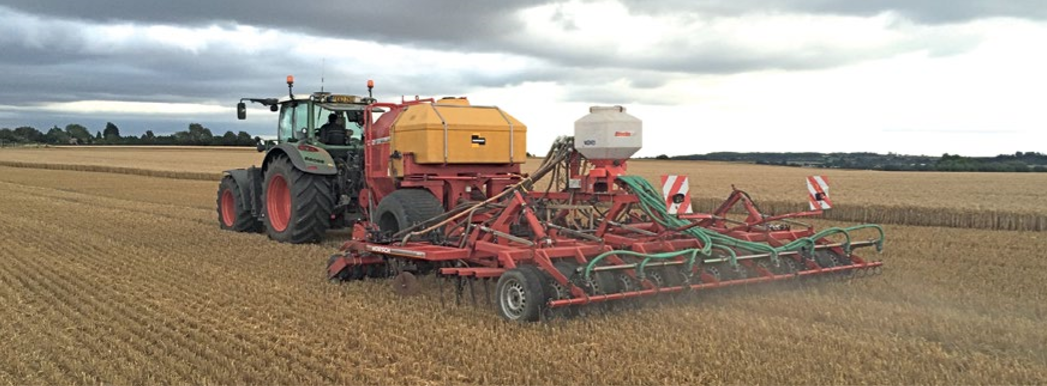
How To Start Drilling For £8K
Clive Bailye’s seed drill of choice is his 6m John Deere 750A , which has been used exclusively for 3-4 seasons. Last year, with an increased acreage, the founder and publisher of this Direct Driller magazine thought a second seed drill was necessary. Having just the one machine was a risk and in a difficult season would mean drilling was delayed. He looked around and found a good condition Horsch CO6 tine drill advertised in Germany.
Words and pictures by Mike Donovan
After delivery he rebuilt the coulters to a narrow profile so as to reduce soil disturbance. He says the tine drill is very useful driling after straw crops such as osr and also through the straw on second crop cereals.
Buying the drill from a German farmer was not particularly complicated, and provided him with a higher spec machine than Horsh sell in the UK. The seed dart tyres are much wider, and the machine is fitted with blockage monitors as well as full width front packers and also a liquid fert application system.
A sheaf of photos were taken, and Clive then asked for some of specific parts to show wear. The deal was done at under £5,000 which Clive says is the market value of these machines which are too large for small farmers to buy. Original owners like to buy new and sell when the machine is still in good condition.
Narrow tines with wear tiles
@Clive knew he wanted to make changes, substituting the Horsch tines and coulters for something far narrower, and has ended up getting his own design of tine made, which has a wear tile made from Ferobide, far harder than tungsten. The drill is on the farm primarily for osr and 2nd crop cereals drilled into chopped straw and the 25cm spacing is okay for these crops.
Comments on Clive’s on-line forum, TFF, said the drill many not be so good with beans, as the slot is a mere 12mm wide. And in barley the spacing may well be too wide as it needs to be thick. Clive points out that the seed pipe can actually be a bit wider than 12mm as it is in the shadow of the point. It would be good to have the option of using it for beans.

Above left: The cheap CO6 is being calibrated ready for its first outing

Above right: The adapted Horsch is being filled by the home built drill logistics trailer with seed and liquid starter fert.
Getting around the German instructions
The Horsch came, of course, with a control box and instructions in German. More on-line discussion revealed that English instructions were available on the Horsch website, and another explained that Horsch was sourcing some of these parts from Agton in Canada anyway. Zealman from New Zealand explained that the button marked with callipers should be held down for around 5 seconds. The menu is where you adjust the tramline sequence, valve layout and row numbers.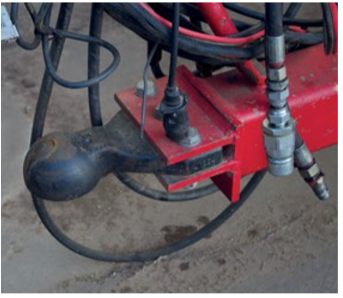
Ball hitch is a continental standard and provides a positive connection between tractor and drill

The Stocks Wizard has a rotor modified for Avadex which otherwise leaks everywhere
A Stocks Wizard is on the back of the drill and used for Avadex. Here again the knowledge of actual farmers is helpful. Alistair Nelson warned that the rotor and the surrounding shroud need to be changed, and he got good advice “from Rick at Stocks”. Clive has the same setup on the 750A and says that the Avadex leaks everywhere unless the modification is made. The drill was acquired and modified in 2016 and the results have been excellent.
The machine went through the residue without many problems and having the second drill has meant more timely planting. Clive has shown that moving into No-Till is not the expensive exercise so many farmers think it might be. The total cost, after modifications which included replacing all tines and coulters, was under £8,000.
Author Mike Donovan writes: we have featured a number of home made direct drills in @Practical Farm Ideas, and are always interested in seeing more. Please contact mike editor@farmideas.co.uk or 07778877514.
-
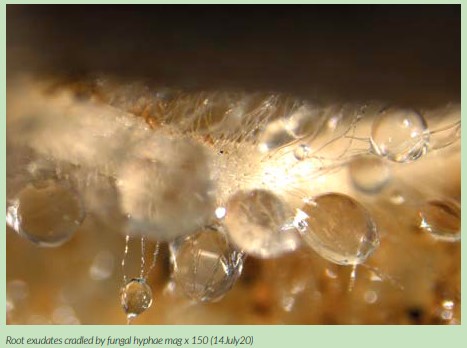
Biological Pathways To Carbon Rich Soils
Webinar with Dr Christine Jones
Dr Christine Jones will be well known to anyone that has been studying soil health or regenerative farming as her
reputation spreads far and wide. I first saw her speak at Groundswell in 2017 and have spent many hours watching
YouTube videos ever since. Christine is renowned for speaking about the Liquid Carbon Pathway which explains how
carbon is a dynamic product in the soil.
Carbon is a hot topic in agriculture across the world at the moment, mainly as a commodity that could be sold to buyers that need to offset their corporate carbon footprint. I believe that this is missing a fundamental piece of the jigsaw which is that Carbon is the basic currency in the soil. It is traded for nutrients and other essential resources by plants and microbes, so the loss of carbon in our soils means that they simply don’t function as well as they should. By paying attention to carbon management we can improve function, reduce inputs, produce food that is better for consumers and crucially be more profitable. In addition it is clear that carbon plays a key role in providing wider Ecosystem Services, including climate resilience.
Dr Jones explained how photosynthesis was the real foundation for all life, as it uses free resources to drive energy into the system. Green plants use light, CO2 and water to create carbohydrates that are exuded into the soil through plant roots. Here the microbes in the rhizosphere exchange the carbon for other products that the plant needs, which in turn facilitates more photosynthesis and the cycle continues. In a monoculture, the variety of microbes in the rhizosphere is quite limited, but in a multi-species situation there is an increase in both number and diversity of the microbial population. This diversity can be increased by the improved photosynthetic efficiency of a diverse sward, as the variety of leaf architecture means that more sunlight is intercepted. More light interception delivers greater photosynthetic capacity, driving more exudates into the soil that feed higher populations of microbes.
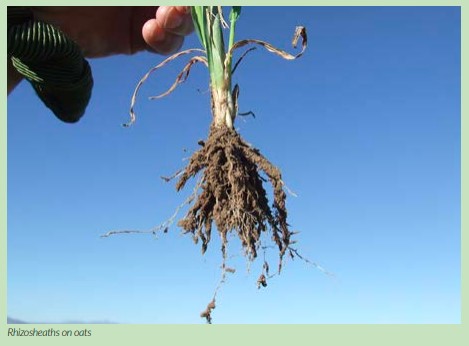
So why are microbes important? I can remember being taught that it was the roots that took up the nutrients, but in fact it is the microbes that facilitate this. They are far more efficient and numerous, as long as we look after them properly. Microbes have a huge array of different functions and services that they can provide, so diversity of the population leads to a wider variety of services being provided. Dr Jones listed some of these – aggregate formation; Nitrogen Fixing; disease resistance; frost resistance; drought and flood tolerance.
In my own experience of using diverse cover crops, soil structure improvements are the most obvious and rapid visual changes (VESS Assesments). Dr Jones explained that aggregates make the soil particles far more water stable, preventing erosion. However they also provide improved drainage in times of water excess and hold moisture inside them for use in times of drought. These can be huge benefits and as climatic conditions become increasingly challenging, surely they cannot be ignored.
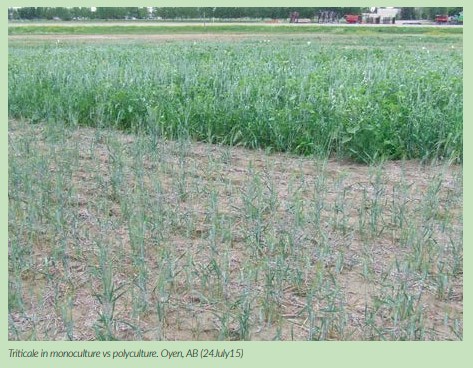
The diverse mixes were also shown to deliver immediate benefits in a growing crop. An example was shown where a monocrop of Triticale was grown in a field next to a mix of Triticale with Oats, Radish, Sunflower, Peas, Beans, Chick Peas and Millet. The history of the field was uniform, but the monocrop succumbed to drought quite badly. Incredibly, despite the increase of competition for available precipitation, the multi species crop showed no signs of moisture stress and grew really well. This can only be explained by the diverse microbiome of the multi species crop accessing moisture and nutrients that the monocrop could not reach. At Oakbank we have seen similar results when using Companion Crops in winter oilseed rape, with an improved nutritional profile in the leaf analysis compared to a monocrop with the same applied nutrition.
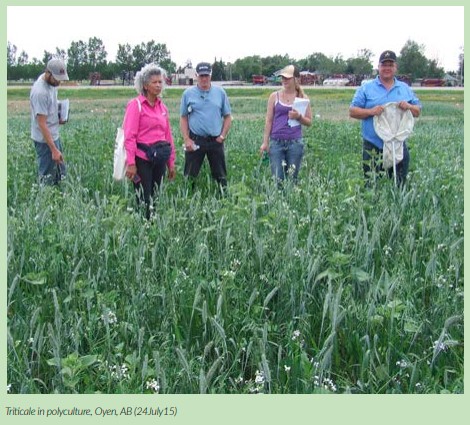
Improved nutrients within the plant are not just good news for the growing plant, as they also provide enhanced nutritional value for grazing animals. Dr Jones mentioned work carried out by Dr Fred Provenza that showed how a mixed sward containing grasses, legumes, tall and short herbs (or forbs) was able to deliver significant benefits to the animals. The diversity in this type of mix delivers a diet that is high in secondary plant compounds such as bioflavonoids, carotenoids, polyphenols and anthocyanins. Dr Provenza’s work showed that these compounds delivered a number of benefits:
• Increased microbial biodiversity in the gut
• Increased ability to digest a wide variety of feeds
• Improved feed conversion efficiency
• Improved immune function
The question you could be asking yourself is could this translate to nutrient density and diversity in human food stuffs, which then leads onto the discussion about using food as medicine. I saw an excellent presentation on this given by Dr Daphne Miller at No Till on the Plains last year (available on YouTube) called “Our Soil, Ourselves”, recommended viewing!
Possibly the most memorable part of Dr Jones presentation was when she showed the effect that high analysis fertilisers have on the rhizosphere. In simple terms it could be stated that products such as DAP almost sterilised the roots, leaving them white, with no rhizosheath and no microbial interactions. It was explained that if the main nutrients were provided in such high concentrations, that the plant put no effort into exudation. This can often give the impression that all is well in the early stages of crop growth, with rapid lush green plants coming through. However, these plants have none of the resilience to stress that can be provided by effective associations with the microbiome, so they succumb to pests, disease and drought far more quickly.
Dr Jones recommended looking at the work undertaken in the Jena Biodiversity Experiment and summarised the effect of plant diversity as follows:
• Restores Ttopsoil
• Replaces fertiliser
• Renders insecticides obsolete
• Makes fungicide redundant
• Supports beneficial insects
• Displaces weeds
• Improves landscape function
The thorny subject of testing for soil carbon was also discussed, with Dr Jones explaining how the sub-soil was very important for stable carbon sequestration. An analysis of 2700 soil profiles had shown that 42% of the carbon was stored in the 0-20cm horizon, but 58% was stored in the 20- 100cm zone.

My interpretation of those figures is that the subsoil is where it’s all happening in regards to the sequestration of stable soil carbon. We need to concentrate our efforts on having deep rooted plants in order to capitalise on that potential. Most measurements are only taken on the 0-10cm or 0-15cm increment of the soil profile, hence they miss the bulk of the soil carbon. On one farm in New Zealand, that Dr Jones calls “The Carbon Capture Farm”, the difference between monoculture ryegrass swards and a diverse mix has been demonstrated at different soil depths. The soil on this farm is a pumice with little natural fertility, but the soil building that could be seen in just a few months was quite remarkable.
The figures shown are the Soil Carbon % and it can be seen that at the deeper zones, the diverse roots have sequestered approx. double the amount of carbon as the monoculture. These types of mix are effectively what is being facilitated by the current Countryside Stewardship options AB15 and GS4, so it would be worth paying careful attention to what is in your seed mix to extract the most value from this “fallow” period. Remember that carbon is the currency for many more benefits, so bank it while you can and it will pay back over time. Plant roots have been shown to build soil carbon between 5-30 times faster than the carbon derived from above ground biomass. This goes back to what Joel Williams discussed, saying Roots not Shoots are what you should be looking for.
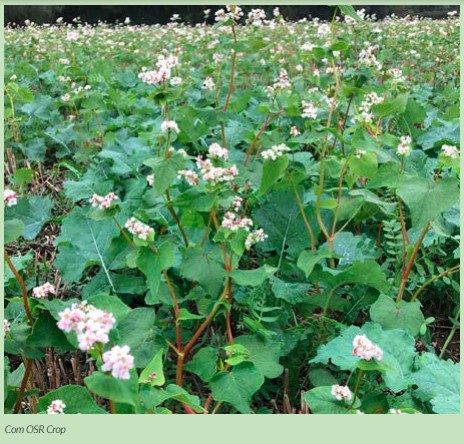
So can farmers really get paid for soil carbon? Well in a number of countries this is certainly true, but the first one was Australia where there is a Federal Government Climate Solutions Fund. Farmer Niels Olsen sold the world’s first carbon credits under a government regulated scheme in March 2019. His soils were recorded as sequestering 11.2t CO2e/ha in 2019 and in 2020 this figure went up to 13.7tCO2e/ha, resulting in a total of 24.9 tCO2e/ha sequestered in 2 years, using multi species swards. Researchers estimate that 2/3 of the carbon was derived from root exudates. If these figures seem very high, remember that to get the tonnes of carbon you need to multiply the CO2e figure by 0.27, so 2019 was about 3 tC/ha and 2020 was another 3.7 tC/ha. The value of carbon credits are expected to rise significantly from their current position, so these numbers could become very attractive, whilst still farming the land remember!
Dr Jones overall message was that the ‘secret’ to sequestering soil carbon was to stimulate the soil microbiome, which requires greater plant diversity and less synthetic inputs. My suggestion is to start looking at this on your own farm on a small but meaningful scale, my clients that have done this rarely go back and feel very positive about the changes.
-
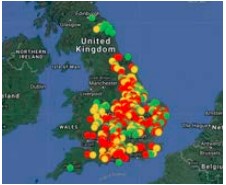
NIAB CSFB Project
In recent years, NIAB have been conducting research to help growers manage their oilseed rape crops in the presence of Cabbage Stem Flea Beetle (CSFB). We are all aware of the fact that in most of England, the area of this crop has been decimated and UK wide, we are now growing half the area we were before the removal of neonicotinoid seed treatments.

The autumn survey run by NIAB in recent years has shown the geographical spread of the problem with the map showing results from autumn 2019 with the red dots being crop failures and the yellow significant damage.
In light of widespread pyrethroid resistance, control of CSFB now relies primarily on a range of nonchemical control methods that either allow crops to avoid the pest or mitigate against its damage. However, more work is needed on a farm scale to identify how reliable these methods are, the situations in which they work best, and the benefits that can be gained by using multiple methods in concert.
We accept that what we have to do is learn to live without insecticides and manage our crops in ways that allow us to get at least a profitable yield in relation to the whole rotation but possibly less as a stand-alone cash crop. As a break crop, oilseed rape has performed greatly over the last few decades and our team feels that it still has a place in arable rotations. With this in mind, we now need to explore whether what we have learnt from small plot trial carries through into commercial crops. With that aim, csfbSMART has recently been launched. csfbSMART – ‘Sharing Management and Agronomy Research Tools’ – is a new industry-wide monitoring and trials programme set-up to test management methods for use against cabbage stem flea beetle on UK farms.
The programme connects two research projects investigating CSFB control. The first, ‘Reducing the impact of CSFB on OSR in the UK’ aims to improve understanding of the pest’s biology and investigate alternative management methods, led by ADAS and Harper Adams University and funded by AHDB and a consortium of industry organisations. The second, ‘CSFB: evaluating management of oilseed rape on-farm for maximum margins’, led by NIAB and Rothamsted is funded by Defra.
The coming together of these two projects along with the backing of the trade allows us at last to look at a range of management techniques that have developed lots of anecdotal information which pulled together over time will provide proper evidence. Growers and agronomists will be encouraged to sign up, but their level of involvement will be their choice, from providing cropping details to carrying out field scale trials. The team will provide advice as to what and how different management techniques can be carried out together with adult and larval monitoring techniques should growers wish to carry them out. Those carrying out field scale trials will be provided a point of contact who will stay in touch for the three-year duration of the project.
All of the team involved believe that csfbSMART is a unique, oneoff, opportunity, drawing together everybody’s knowledge and experience in a coordinated and sustained effort. We aim to support farmers, to monitor, assess and share information, building a national and seasonal picture of the pressures of CSFB larvae and adults within oilseed rape crops and the wider farming environment. One of the big issues in recent years has been crop establishment. Making use of available soil moisture has been key to getting the crop established. The project will give us the opportunity to collate information from a range of regions, soil types, drilling dates and varieties. We will be encouraging growers to assess and record the behaviour of their crops through emergence and into the autumn so that even where growers are not carrying out field trials, we still aim to collect information and in many cases, we will be able to add larval counts through the winter and into spring.
One comment we do hear is “I am trying this but have no idea if it is making any difference”. With the help of researchers and a coordinated approach, we aim to answer these questions and compare results with similar techniques in different regions.
We will also be looking to create clusters of growers with a dedicated contact to help share information and assist those who wish to explore new management techniques. Over the next few month, we will be rolling out information and kits to help with monitoring so that we can be ready to start in the summer. The project has had its first online meeting and we are excited that we have a range of growers looking to be involved.
We have a long list of questions including those below which with growers help and feedback, we aim to shed light on.
• Do organic amendments make a difference to larval numbers?
• Do WOSR volunteers left to grow close by make a difference? Can I manage volunteer OSR to increase effects?
• Does stubble height/management of the previous cereal make a difference?
• Should I establish WOSR with a companion crop? If so what?
• Shall I graze or mow my wellestablished crop to reduce larval numbers?
• How do I use trap cropping most effectively?
• Which variety is least palatable to CSFB?
• Which varieties recover best after CSFB grazing?
• Which varieties recover best from CSFB larval damage in the stem?
For several years, NIAB has been monitoring CSFB adults and we are looking to continue this whilst getting more growers involved so that they can begin to use better local knowledge to help them make their own decisions.
This will also include training and help with using the Syngenta water bath method for assessing larval numbers in the winter and spring. We will also be looking at novel techniques such as funnel trapping which has been tried on long term trial sites at Morley as another way of monitoring larval levels later in the year. The use of funnel traps (pictured below) within trials in 2018 and 2019 successfully captured falling larvae as they left the plants in the spring; on average 14 larvae per trap.If scaled up this is approximately 5.5 million larvae leaving the OSR plants per hectare over the 24 day period, providing context to the scale of the issue growers are facing. This data also shows the potential of funnel traps as a low cost, relatively low input method of capturing larvae data in crops in order to be used for comparing methods of Integrated Pest Management in OSR. However, it is recommended they are used in combination with either one of or a combination of foliage and stem damage scores, yellow water traps and plant dissection so data from the novel method can be linked to pressures on crop and treatment effects.

We hope over time that this project will grow in size and that we can help growers to understand the best establishment and management techniques to help them manage their crops in the presence of this pest.
-

Drill Manufacturers In Focus…
WEAVING DEBUTS NEW BRITISH-MADE GD3001T 3M TRAIL DISC DRILL

We at Weaving Machinery always listen to what our farmers need, so we can continue offering innovative machinery at affordable prices.
This approach has resulted in the launch of our new GD3001T to meet demands from farmers for a scaled-down version of larger trail models. The 3m trailed disc drill packs exceptional power into a compact design for handling grain and fertiliser. Dual cropping is also an option – the drill’s front row can be used for small seeds and the back row coulters for large seeds, making cover cropping straightforward and simple. Alternatively, both tanks can be used for grain. Whether you have a mixed farm or want excellent performance at a smaller scale, this is a powerful new drill that offers consistently high-level operation.
Following customer requests, we are also proud to release our new Front Tank. Up until now, these have been built purely for our Combi Drills. As more and more farmers seek better weight distribution, we saw a way to upgrade our offering. The new tank is fitted with a sleek stainless steel double metering unit, higher output capabilities, a twoton capacity, and extra “quality of life” features like front row lights and built-in cameras to aid pulling out at junctions.
We are also pleased to announce our new Shortdisc, which makes ease of use a priority along with better performance for chopping up trash at shallower depths, thanks to the new wavy disc design.

The new cast V ring rollers can handle wet or dry conditions without blockage, and each of the 3 sections can be easily replaced in the unlikely event this is necessary. Additionally, the Shortdisc can be used alongside our multi-purpose Magnum Seeder for drilling cover crops while going over stubble. Constructed entirely in the UK, the new Shortdisc is available in working widths of 3, 4, or 5m.
Amongst our new offerings is the Fenix Grass Drill. After two wet winters in a row, a lot of farms are hoping to reseed their winter grass but are cautious about ploughing. This new drill which will be brought to market from April 2021 is built with this in mind, able to stitch grass in a narrow 3-inch row using its serrated disc, with a full width press roller at the back and an option to block off alternating coulters for wheat, barley or oats. With its 3 metre working width, 80-100 HP requirement and electric metering, this compact machine is designed to be small but mighty, ideal for smaller farms.
The requirements of successful farming are always changing. At Weaving, we never stop developing new equipment that meet the real needs of our farmers. In just the last couple of years we’ve had incredible feedback for our newest Sabre Tine Drill, which gives the user freedom to move towards either minimal cultivation or conventional cropping, all while handling damp conditions and needing very little horsepower. A new 8m width will be available in Autumn 2022.
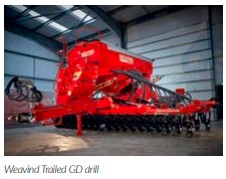
We have also received an excellent response to our recent interrow Mounted IR Drill, which lets farmers drill two or three rows of grass between maize in all weather conditions resulting in significantly less soil erosion and compaction whilst providing a crop of grass for livestock during winter if necessary, or available for silage in early spring.
It’s been a difficult year for everyone but farming hasn’t slowed down. Neither have we. Weaving is dedicated to fitting the needs of our farmers, whatever they may be. Our popularity is due to our straightforward nature. What you see is what you get, the price you see is the price you pay, and we are always on hand to help set up and provide assistance as required. Following two difficult autumns, we would like all UK farmers to know that we’re geared up to deliver exceptional machinery and are here to help.
To see these machines in action, join us at Groundswell on 23rd-24th June. We hope to see you there.
-
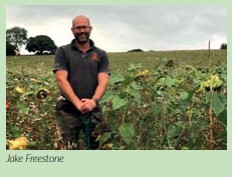
Why Take The Regeneration Road?
Herefordshire farmer John Joseph writes: In the January edition of Direct Driller, I was impressed by the article ‘Regenerative Agriculture…. Fad or system’ (William Waterfield) because it showed how useful this system is becoming and it took me back to my youth, (which is a challenge) when what we refer to as Conventional agriculture was at its height and still growing. On numerous occasions we watched as new ideas, normally based on organic farming, came to the fore and were then carefully laughed out of existence. Time and time again I heard the phrase, ‘this is it this time’, just to watch it dwindle away in the smoke of exhaust fumes from the chemical delivery lorry. I too have to admit that back in the day when I had a proper job actually growing plants that a non chemical system didn’t register at all, in fact if modern me turned up to see me back in the seventies and eighties I would be told to sling my hook (or something similar to that anyway).
Written by Nick Woodyatt from Aiva Fertiliser
Now this started me thinking, what was it that finally turned us, (well some of us), from chemical junkies towards a more sustainable system that our children will not look back on in despair and anger which is how I view my own growing past. My reason for this is not just being nostalgic but perhaps those who are just thinking about coming into the light might like to hear this from me and a few others who I have asked this question.
For me it started in 1995 just after I had stopped growing and entered the shady world of sales (yes it is, I was there). To be honest my old boss and I never really believed what we were told; consequently, I did all my own trials the results of which are so valuable to me now, so I didn’t get caught on the con but as soon as I went into the office scene it really was quite frightening. My own epiphany came when a chemical called Fongarid disappeared which had been the go-to chemical to kill Phytophthora, Fusarium, and Downy Mildew. As there was no replacement the industry was doing its normal, ‘oh woe is me’ routine so I decided to have a go with Bacillus Subtilus which was so much better than the chemical had ever been. Since then, nearly all my trials have shown that this is a way forward but unfortunately, we will have to wait to see the fruits of this work as most of the powers that be are joined at the hip with the chemical companies. Over the past two years with my overseas contacts, I have rid soils of Leatherjackets and Wireworm with Beauveria Bassiana, Frit Fly larvae with Bt and no end of diseases with a batch of bacteria. The thing we will have to note when we can do this is that they work better in groups with a food source rather than as lone wolves.
So this, along with my experience with chemical companies when I was a National Sales Manager (I had to move to New Zealand to escape), was what prompted me to look at a more sustainable way forward. By the time I returned from New Zealand the terms Regenerative Farming and Carbon Capture Farming were the terms being used to soften the blow and move away from the frightening organic word. The question is, `What was it that moved others?’ They cannot all be cynics like me, surely.
John Joseph is a farmer in Herefordshire and started his journey back in the nineties which explains why his soils are so much darker than his neighbours. John says that he had felt like he was on the hamster wheel just adding more and more products and spending more time working for his suppliers and needed an alternative. Added to these, two wet years had done an enormous amount of damage to the top soils as there was nothing holding them together explaining why no root structure was visible. This threw up many questions but the main one was simply economic as there was no future following this system. My question to John was that for smaller farms is it not easier to follow a conventional system with its list of fertilisers and chemicals rather than the hard thinking that is necessary for regen systems. John replied that the work is worth it in the end.
He had started regen farming almost by accident as he started using cover crops in the early nineties; ‘People thought we were trying to pinch their pheasants’, John says. `I was drowning in a sea of cultivation and poor crops, so I needed a change and direct drilling gave me the time I needed.’ The cover crop work that John did meant that the change from ploughing to direct drilling was fairly simple, but it is this change that can define the successful regen farmers from the ones who are trying to get from A to Z far too quickly. Now John is starting to enjoy farming again, reporting that he can see more root on a grass lay in 3 months than I did in a year before. The strip till arrived in 2013 which is a marvellous first step, in my opinion, as it keeps air in the soil at a maximum. This last winter an Avatar drill has arrived and has a place of honour in the shed and John reports it as fantastic. John also agrees with me that a liquid applicator on the drill is an excellent investment and allows so many options from fertilisation and microbial inoculation.
Farm owners can make the decision to jump to regen farming as they only have themselves to please but looking at change from a manager’s point of view can be whole different ballgame. In my working lifetime I have always had a respect for managers as they have to balance the needs of the crop with the expectations of the owner or the board. In fact, I think I can make the statement that any manager has to have a likeminded owner to even contemplate going down this route.

In the case of Jake Freestone at Overbury Enterprises he was brought onto the farm by a family who felt the responsibility of the past and the future and needed someone to take the soils forward. Jake was a Nuffield Scholar who had studied regenerative farming and had the necessary knowledge to put the right team together and to work out a system that trialled products and systems so that they could be fully incorporated if they gave the required results. As well as getting the desired yields Jake says that his overriding mission was to increase the value of the land for future generations. Jake introduced trials of cover crops and direct drilling onto the farm but still managed to balance yields and soil improvement and anybody who has had the pleasure of visiting Overbury knows that it has been done to a superb level.
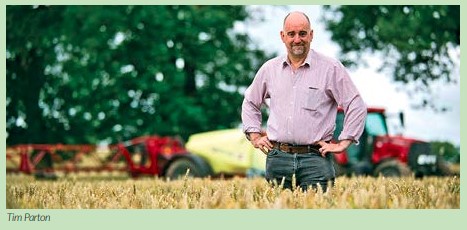
One point that Jake made was that he felt it essential to have an independent agronomist who works with the farm looking at the pros and cons of everything that is done. It is having this truly independent advice that is so difficult in Agriculture and yet so important regardless of the system that you are in. Having agronomy and sales so closely linked has done the worldwide industry and soils unmentionable damage, but that is only my opinion. I find it a fact of incredible regret that most advice given on the farm from companies and organisations is fuelled by the chemical companies which is why I shout that I am a salesman every time I do any talks or presentations. If any farmer is looking for the takeaway advice from this, then that is read, listen to everything and then, make up your own mind.
When I asked if he thinks Regeneration Farming is here to stay Jake answered, ‘It has to be based on all we do from profitability, environmental issue and Biodiversity; you should see the wild birds on the farm’.
Isn’t it a shame that farmers such as Jake and so many more are not being given the credit they deserve by the BBC and their environmental programmes that make farmers out to be the enemy of the world and wildlife?
At Brewood Farm North of Wolverhampton, Tim Parton has also seen a huge increase in birds around the farm following his involvement with local bird groups. This sort of thing takes time and effort, but Tim adores watching the birds and gets satisfaction from once again enjoying farming flowing his conversion to Regeneration Farming in 2009. Tim who has just won yet another award, this time ‘Innovation Farmer of the Year’ from the Farmers Weekly, is certainly one of the biggest advocates of regen farming there is, and his knowledge base of the system is quite frankly stunning.
‘I had to change because the farm soils were simply collapsing and needed regeneration,’ says Tim, ‘and we did this for the sake of the soil and not for saving money although that came later.’ Tim followed what is now thought of as a great way in to regen farming which is to dump the plough and go to a strip till system along with putting 50% of the farm to spring crops. Tim agrees with me that there is no need to see a dip in yield if you follow a step-by-step approach.
‘It took around 3 years to see a huge difference in the soil when massive numbers of worms started to appear and now roots grow down rather than out.’ Biology is a huge part of what Tim does and he has replaced his Nitrogen addiction that all farmers had with a brewing addiction.
‘We have to replace some of the microbes that we destroyed before the soil can truly be classed as balanced,’ Tim suggests. Microbes are applied with a liquid applicator which is very similar to Jakes at drilling and regularly over the crop to keep them happy so that fungicides are not needed. Whether applying microbes or feeding up the ones that are there it is vital to make sure that the carbon levels in the soil are kept elevated as the carbon is the lifeblood of everything that lives.

An important note here is not to rush things. A farmer saw what Tim was doing and thought … I want a bit of that but was not willing to do the work so just went for broke and bought a 750a direct drill. Of course, the soil wasn’t in the proper shape to accept direct drilling so everything failed and then of course it was the drills fault which is a shame for the drill and the farmer.
Just outside Leamington Spa Alistair McGregor is just starting the regeneration journey as it is called although cover crops and reduced tillage has been on the farm for quite some time. Alistair sees Regen farming as a way of further improving his soils and getting a more sustainable system. As a farmer with a young family having a system that leaves the farm in better condition than he found it is as important as looking at profitability. When asked if he can find the information Alistair says, ‘There are lots of experts out there, but they often don’t agree with each other which works to stimulate debate’.
As always it is a case of finding what works for your farm and the most economic price. Alistair does like to have a local farm group in which to discuss things and can see the importance of wider groups such as BASE where like-minded people can share views or have a damn good argument, after all they are farmers. As ELMS continues in discussion it is obvious that this is the way forward and Alistair can really see the value of Carbon Credits that will soon be a major source of income into the farm.
Although I totally believe in regen farming and having an environmental part to what we do I think we have to be careful. I have spent a lot of time in units in Africa where giant farms are growing food for this country where many cannot afford enough food to survive. To then return to this country and see that farmers are being paid to turn the countryside into a park does stick in the craw a bit. I would love a few politicians and the BBC to go to Africa and explain to those starving people why we are taking their food. That could just be me though.
So, there we have it. More and more farmers are looking at moving to a regen system and it is just for me to say that the information that you need is there ready for you to read and disseminate. Not everything works for everyone, but it never has plus we are still at the mercy of the weather. Try a field and move forward and things will soon start to improve and with the environment becoming the most important policy there is the time is right.
My last point is that there are some farmers who are simply nowhere near ready for this system yet and if you are one of them there is no shame in that but please try to think it through. I went to see an old friend some time ago and his last remark was,
‘This is interesting, but can you tell my [company] Agronomist as he makes the decisions here’; Good Grief.
-
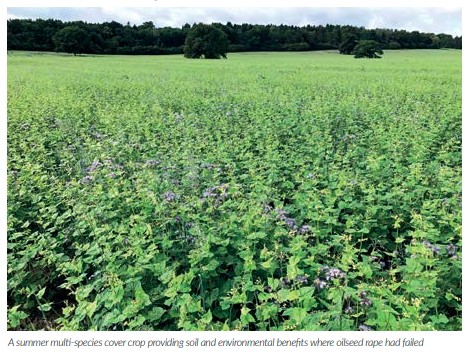
Regeneration Is Restoration
Written by David Boulton of Indigro
Born out of an industrial and intensive era, ‘regenerative’ and ‘regeneration’ are the newest buzzwords to describe a forward movement in agriculture.
By definition, regeneration is the process of restoration – to develop and improve something, making it as good or successful as it previously was. In an agricultural context, it is a holistic approach to improving farmland, by enhancing natural ecosystems and working with nature. At its core is the protection and restoration of the soil, the quality of which is the foundation for agricultural productivity and environmental resilience.

Following the agricultural revolution in the early post-world war period, landuse changes and the intensification of soil cultivations and synthetic product use has led to the provision of plentiful and cheap food, to meet the needs of an expanding population – but at what environmental cost? Agricultural efficiency has increased, with generally larger and more specialised enterprises. However, permanent pasture has been converted into continuously cultivated arable regimes and the use of pesticide and synthetic fertiliser has increased.
This current system faces many challenges, including widespread pest resistance, agrochemical and nitrate contamination of water, increasingly stringent plant protection product regulations, soil erosion and declining farm biodiversity, to name a few. We have reached an economic and environmental tipping point and require a more positive direction of travel.
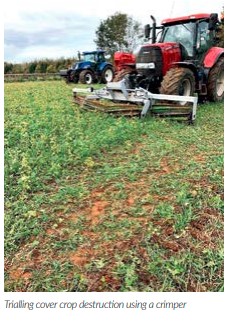
The principles of regenerative farming
There is no single regenerative blueprint that will work on every farm and soil type, and each site will have its own unique challenges and opportunities. For example, poorly drained heavy clay soil will not be conducive to delayed winter cereal sowing or planting a spring crop after grazing a cover crop with livestock in marginal conditions. There are, however, several underlying principles. Soil cover must be maintained, by returning crop residue and establishing catch and cover crops between cash crops. Miniature (small leaved) white clover can be very successful in providing a permanent, nitrogen fixing understory, that can be grazed by sheep when not in a crop.
Maintain a wide and diverse rotation (including the use of different cover crop species) to control weeds, pest and disease, utilising winter and spring crops. Use companion crops where possible, especially in oilseed rape, to provide diversity of root architecture and to capture nutrients.
Utilise organic manures and amendments, such as compost, digestate, biosolids and farmyard manure. These are not just excellent sources of crop available nutrients but also improve soil structure and build soil organic matter. Having livestock enterprises can help add another income to the business and are an excellent way of destroying cover crops. In conjunction, aim to cut down manufactured nitrogen use, because this will help to significantly reduce the carbon footprint of the farm, and will also make crops less dependable on other inputs such as fungicides and growth regulators.
Crop establishment should revolve around minimal soil disturbance. Since regenerative farming is not a prescribed approach, farmers and land managers have the ability to decipher and select which technique will suit their system the best. Either a low disturbance tine or disc drill may be appropriate, based on soil type, blackgrass pressure and cover crop destruction approach. A further aspect is following the principles of integrated pest management (IPM) and using this process when making any agronomic decision on a crop.

Current constraints
A key question hangs over the dependency of the regenerative system on glyphosate. This broad-spectrum herbicide plays a crucial role in the destruction of problem annual and perennial weeds, such as blackgrass and couch grass and is also a dependable means of terminating cover crops and grass and clover leys. Alternative chemical molecules and weed control strategies are being considered and will most definitely be required. The destruction of cover crops can be successfully achieved using crimper rollers, livestock, toppers, and with some assistance from consecutive hard frosts. However, selecting the right species in the cover crop and timing of destruction is vital.

There are also challenges with making the system work on poorly drained, heavy soil types, which incur low yields, inefficient resource use and nitrous oxide emissions. The yielddrop in the transition period, dealing with compaction and managing the decomposition phase of the nutrient cycle when cover crops are destroyed are key aspects that require further understanding.
Managing risk by farming for the environment
Farming regeneratively, is intrinsically, farming in a manner that supports the natural environment. Working together, the implementation of countryside stewardship can help to reduce the financial risk of the system, particularly where there is a yield decline in the first few years of transition and facilitate the improvement to soil quality.
Options such as legume and herbrich swards, buffer strips and winter cover crops compliment the aims of a regenerative farming system and provide a fixed income, irrespective of turbulent weather and commodity market pressures. With the Environmental Land Management scheme on the horizon, I would like to see greater flexibility with regards to the management and implementation of stewardship options, and further collaboration of neighbouring farmers to provide large scale environmental benefits.
The direction of travel towards carbon offsetting
The regenerative model places growers in a unique position to both lower the greenhouse gas emissions of one’s own farming business and sequester the emissions from other industries and businesses. At present, there is no standardised accreditation for the process of carbon sequestration via land management in the UK, however, a ‘soil carbon code’ or similar scheme will facilitate the trading of carbon credits.
Potential incentives from government could be coupled with voluntary market initiatives, stacking the monetisation for land managers of regenerating their soils and farmed landscape. The challenge for the industry will be how best to measure and quantify successful outcomes for accreditation. Most likely, it will be a combination of satellite imagery and geospatial soil organic matter sampling.
A knowledge and collaboration driven approach
Being a holistic approach, the knowledge and level of understanding that is required to make the system work is greater than that of a traditional system. It is important that land managers and farmers seek advice from as many different sources as possible and learn from each other’s experiences. Truly independent advice, that is not linked to the sale of inputs, whether that be conventional pesticides or biological products, is essential.
Whilst there are many names and guises for farming systems that emphasise improving the quality of soil and natural ecosystems, regenerative farming is an empowering and farmer driven approach that combines productivity with environmental sustainability and will greatly benefit future generations.

-

Farmer Focus – David White

“It’s not about the machinery”, except once you get into cover crops and producing larger ones it is about machinery because without a drill that can cope with big volumes of vegetation cash crop establishment is compromised. An interesting video worth seeking out in the YouTube Horsch Live series showing on Feb 24th https://youtu. be/OoifwgXbEZ0 featured Julien Senez who talks of 4.5 ton biomass cover crops as being the target for adequate nutrition generation/recycling. Whether drilling green in the autumn or into early desiccated spring seedbeds this volume requires a cutting disc to avoid blockages. Another problem I have come across now I’m drilling second wheat is how you drill into big catch crops with an “understory” of wet chopped straw. Hair-pinning is always the worry and on soil that has been in Regen Ag for a few years with a residue build up in the top 50mm the soil is too soft to cut against. The question therefore arose is there a drill on the market (apart from a Cross Slot?) that would deal with big vegetation, much of which could be laying horizontal ie peas and vetch, and place seed cleanly through chopped straw.
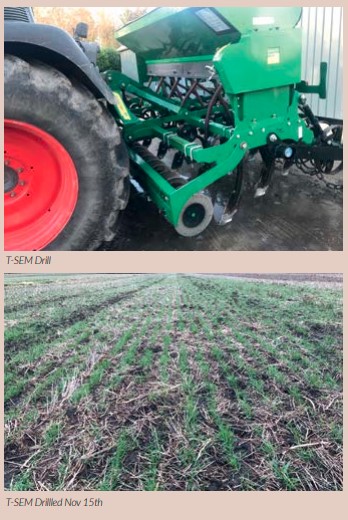
To that end I had two drills on demo last autumn. The first was in fact the first direct drill I ever tried, the SimTech T-Sem. Hands up, five years ago I was on the bottom step of understanding direct drilling and what conditions are needed to achieve even establishment. Certainly a wet undulating stubble that had been previously Discordon’d and Vaderstad drilled was a long way from the firm level conditions I now have on the farm. Establishment across the drill was uneven due to wheelings and my lack of foresight to at least work at an angle didn’t help Lesson learnt, get your fields level in year one. Five years on this November the same drill has done a fabulous job with the slim feet causing minimal soil disturbance if used at a sensible speed with the tine vibration creating enough soil shatter to negate the need for harrowing or pressing over the rows. It did however struggle with an extreme amount of vegetation which may have been combated by pre rolling or it just being dryer! Score 8/10.
The second drill tried was the Virkar from Samagri. This is also a leading disc and tine drill which has many innovative features, and I’d urge you to check out the videos on Youtube. Used on the same high vegetation field as the T-Sem a few days earlier the pressure was on the guys doing the demo as I had invited a few other farmers to see the drill working. Again, we struggled with the high vegetation, soft soil surface and unwelcome shower and the finish could best be described as ugly, but the wheat now looks very well (see pics).
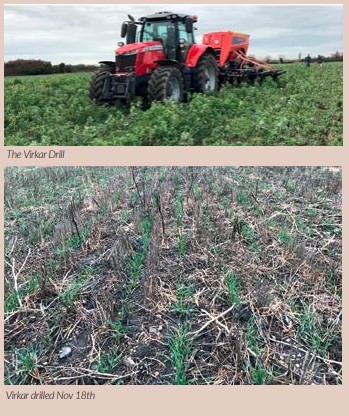
Again, I’d give a score of 8/10 but as the progress of neither drill on the day could have been described a “seamless” in these extreme conditions. I can’t say I’ve found a single drill to replace the need on this farm for a true disc and a pure tine drill. A solution could be to modify the type of cover grown to only include upright species and those that produce less bulk. Sadly, this would be a compromise as knowledgeable farmers (ie Julien mentioned earlier) much further along the journey of Regen Ag promote big volumes of vegetation. I also clearly remember Frédéric Thomas saying when asked at a meeting “you can’t have too much vegetation”. So for me for now its stick with two drills to have maximum flexibility without any compromises.
Experience with light disc “Joker” type machine.

The desire to be able to destroy covers by mechanical means without having to rely on frosts greater than -5 degrees led to me trialing a disc machine a few years ago. The principal worked well as ground conditions were reasonably dry that year in late November. Pluses for the technique were that the green matter was mixed into the top 50mm or so of topsoil to aid breakdown, feed the worms and importantly minimise the rate of glyphosate used. This proved to be successful as a single low rate was used to tidy up some small grass weeds predrilling.
So last summer I came across a very cheap new machine which was purchased and fitted with a small seed hopper to make its role flexible. Like a kid with a new toy I used it on several fields to establish catch crops pre winter wheat with the view to helping chit volunteer seed as well as establish the catch crop. It was operated at about 55mm deep and moved more soil than the Horsch CO that would have ordinarily been used. At the time I was satisfied with the job done however another wet autumn proved again less is more and right through until the end of Feb the moved ground walked wetter with the wheat crop looking less happy compared to where I’d left an unmoved control in the same field
Lesson learned, have faith and stick to the plan.

-

Are You Getting The Most From Your Soil?
Recent interest in carbon trading and the Government’s Net Zero by 2050 target has led to an increase in enquiries at NRM laboratories relating to Soil Carbon, Organic Matter and the link between them. Agriculture can play a significant role in carbon sequestration, with soil providing a huge carbon sink. Understanding the soil and what percentage is made up of carbon plays a key part in being able to effectively manage and increase the carbon stock percentage. The launch of the Environment Land Management Scheme (ELMS) is likely to create more reasons for landowners and farmers to understand their carbon stock. Although the details are not confirmed, it is expected that Soil Health and Carbon stocks will form part of the scheme.
In response to the increased interest, NRM laboratories have developed a comprehensive package which provides an accurate assessment of the carbon stored in soils, applicable to both grassland and arable systems. CarbonCheck provides not just an organic carbon stock figure but also a range of other useful parameters. It uses a combination of individually tested parameters and calculations to determine carbon figures and provides users with a report to enable action to be taken and comparisons to be made. It is recommended that sampling should be carried out regularly to monitor changes in soil carbon stock levels, ideally at the same time of year to reduce sampling variation.
The Bulk Density of a soil gives a good indication of how well plant roots can grow and explore the soil for nutrients, and how easily air and water can move within the soil profile. The Bulk Density of the soil is used to calculate the Organic Carbon Stock. This is carried out using the ‘disturbed scoop’ method. This is different to the undisturbed core method. The scoop method was chosen over alternative methods due to the positive supporting evidence regarding this method.
Sampling Depth and Stone Content details are provided by the sampler on the sample paperwork. This allows the laboratory to determine the soil coverage per square meter. Providing this background data ensures a more accurate assessment of the carbon stock in the soil.
Inorganic Carbon also known as Soil Inorganic Carbon (SIC) comprises of carbonates and bicarbonates which are abundant in chalky soils. The calcium carbonate content of the soil is determined from the SIC and means we can assess how calcareous the soil is.
Total Carbon % is determined using the combustion method, which is comparable with the Dumas method. Total carbon measures both inorganic and organic carbon forms in the soil.
Organic Carbon is then calculated by removing the Inorganic Carbon figure from the total Carbon figure. Also known as Soil Organic Carbon (SOC), it is the carbon component of soil organic matter. This diverse group of carbonbased compounds originates from the decomposition of plant material, animal residues, soil fauna and biota. The level of SOC is influenced by environmental factors and management practices. It is a key measurement in monitoring changes in the levels of carbon stocks. The report provides a visual representation of the SOC and SIC split.
Organic Matter % is a complex combination of all organic material found in the soil including living components (plant roots, microorganisms) and dead components (leaf litter, humic substances). Organic Matter increases the soil’s water holding capacity and provides a slow-release source of energy for micro-organisms, increasing the cycling of nutrients within the soil. This report uses the Van Bemmelen factor of 0.58 to convert Soil Organic Carbon to Organic Matter.
Total Nitrogen % is determined using the combustion method. Nitrogen is the main driver of plant growth and is associated with soil organic matter. It is mobile in the environment and present in many different compounds, some of which are available for uptake by plants. Total Nitrogen is the measure of all forms of nitrogen (organic and inorganic) in the dried sample.
C:N Ratio is calculated using the Total Nitrogen and Organic Carbon results. The proportion of organic carbon relative to nitrogen (C:N ratio) gives an indication of the right balance for soil microbes to support the release of nutrients. The optimal C:N ratio for nitrogen release in soil is between 10 and 12.
Organic Carbon Stock (t/ha) gives a total organic carbon value in tonnes of carbon per hectare of land to the specified sampling depth. This calculation factors in the measured soil organic carbon %, stone content, sampling depth and bulk density. There is also the option of upgrading the package to CarbonCheck Plus which provides an additional measure – Active Carbon. This parameter is also available as a stand-alone test.
Active Carbon (mg/kg) or Labile Carbon is the portion of carbon which readily breaks down and provides an active source of nutrition to soil microbes. The effect of changes in soil management such as cultivation methods or the use of cover crops can be monitored with active carbon analysis as it is a precursor to the long term build-up of organic matter. Understanding the Carbon Stock levels in the soil provides landowners with the opportunity to adjust land management practices to improve Organic Matter as well as providing future proofing against the imminent ELMS policy.
CarbonCheck is available direct from NRM Laboratories, or via your agronomist, advisor or soil sampling provider. You can get in touch with NRM for further information or to request your free sampling kit on 01344 886338.

-

Farmer Focus – George Sly

I’m finally and Agroforester!
It has been 5 years in the making, but we have finally planted our first 16 hectare field of Agroforestry.

We decided to do most of the work ourselves and I am so pleased we did. Farming has become quite an isolated world of technology, screens, twitter and stress along with some good times too of course! But if someone were to ask me what I enjoy the most from farming, it’s the time spent working with my close family doing manual work like planting our trees, not driving tractors. We spent the weekend chatting whilst planting, discussing the past, present and future, having laughs and enjoying the work. In the western world manual labour can be sometimes frowned upon, however it has such powerful effects on mental health and general wellbeing. My father (78), my son (2) and me (34) where all there to help with something that will shape our farms landscape for 50- 100 years. Bloody saw after digging 300 holes and shovelling compost and topsoil.
I have a weird affiliation with trees, have always been interested in them, they make me feel calm and somehow give me peace in what is a stressful lifestyle. I have no idea why, but my gut tells me that purely cropping annuals is not the right choice for my farm for the long term future. I maybe wrong and it’s not for everyone. Our agroforestry system was designed to overcome some key fears. We have planted it largely North/South to avoid the effects of shading.
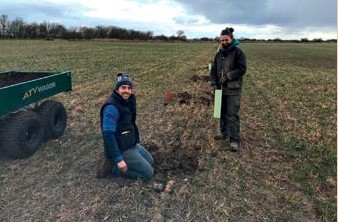
Specs:
24m arable alleys, 4m tree strips, trees planted offset 1.5m from the east edge and 2.5m from the west edge. The offset is to allow harvest traffic on the west side (side where the sun sets which should be dryer). We have started jetting drains, however I am not too concerned about the drainage as trees generally don’t seek the drain unless its blocked. We also plan to install new drainage schemes down the arable alleys over the next 10 years. If I wasn’t on heavy land in the fens, I am convinced from research I have read, that trees may in themselves replace the need for field drains. They help, not hinder. Every tree has its purpose, and it has taken me about 50 books and 5 million hours on google to decide what to plant. We settled on two initial tree row types, the first field alternates these rows.
Row Type 1: Hazelnut – we chose a specific bunch of varieties which have never entered the UK before (a headache with Brexit), they are grown largely for Ferrero (who consume 1 in every 3 hazelnuts grown worldwide) they have a very specific bunch of characteristics which I liked. I was very cautious not just to plant “any tree” but to heavily research the commercial output of the crop, even if they are sold in our local town, they have to taste nice and be disease resistant etc. I was also careful to choose genetics that will suit our site in 10-15 years with climate predictions. Hazels have to blanch well and there is a “blanchability index” which is how well the skins come off during blanching. I don’t personally enjoy eating them with the skin on so spent some time looking at this.
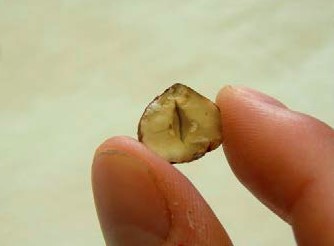
Row type 2: Walnut (cash crop) with nurse trees of Italian Alder, Silver Birch and Wild Cherry.
The walnuts are the only “paying” crop in this row, we have chosen specific fruiting varieties that should suit our site and should grow on to provide an income for me, my son and future generations. The harvesting equipment for hazel and walnuts will be the same. Walnuts nutritionally are near to natures perfection, they are packed with protein (half the protein of chicken per gram), Omega 3, polyunsaturated fats as well as lowering the risk of heart disease, and whilst they grow they sequester carbon, produce oxygen, rebuild soil and provide super nutritional healthy food. Walnuts do contain Juglone (but less in the types I chose), which is alleopathic to crops such as sugar beet, maize and soya.
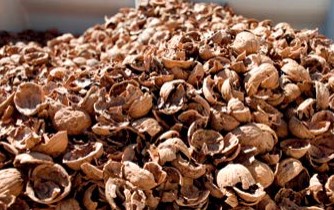
So why not just have tidy lines of walnuts? Because I am trying to completely shift the landscape to a diverse rich ecosystem. The Alder are great N fixing trees, they also grow just about anywhere, they are being planted in the field lows, and they are one of the best trees on the planet for restoring and regenerating soils. Silver Birch are equally hardy soil improvers, and they host over 300 species of insect, this is the main characteristic that swayed me, I want insects and I want to give them back a house on my farm and in my fields. The Cherry are mainly there for the flowers (aesthetics) and pollen for bees and other insects and fruit for birds. For every walnut there is 2 nurse trees 2m apart. Eventually we will fell the nurse trees and replant and use the timber.
Nuts have been described as natures perfect food. Before deciding to start with nuts I first started eating more of them, different types and varieties. They are nutritional powerhouses and they grow back every year… I have played in the kitchen and have some ideas as to what we will do with them before sale. We intend to crack and roast although some whole nuts for the Christmas market hopefully. There is no way, that we will be able to compete with a Turkish hazelnut or a Moldovan walnut, but that is not my aim. We want to put a face, brand and story behind a niche product. I also have to add that the nut shells are something we want to keep, combine with prunings/coppice and return to the land. We also plan to dry the nuts with the previous years shells using pyrolysis.
We plan to use the arable/pasture alleys to rotate livestock, crops, grass etc, we basically now have 13 fields in what was a square 16ha field. I have used the trencher to install some water pipe for livestock so each tree alley has a water supply should it be needed in the future. This was done very cheaply with blue water pipe and our drainage trencher. Our next field involves some berries and fruit as well (which I plan purely for the dried fruit product market not fresh (fresh would be a bonus). This will include some native and foreign berries and fruits.
Overall, I have to say, that I expect the tree rows to equal or surpass the gross margin for the arable crops on a per hectare basis and I hope they will improve and increase the arable yields. In time crops on the east side of the walnuts will suffer a little, but at that point the walnut income should surpass the arable. Its all about having diverse income streams. The carbon payments from the trees will add further income. Farmers are more than willing to visit our farm and field, I am passionate about agroforestry and am more than willing to share what I have learnt so far.
-
What Do You Read?
If you are like us, then you don’t know where to start when it comes to other reading apart from farming magazines.
However, there is so much information out there that can help us understand our businesses, farm better and
understand the position of non-farmers.We have listed a few more books you might find interesting, challenge the way you currently think and help
you farm better.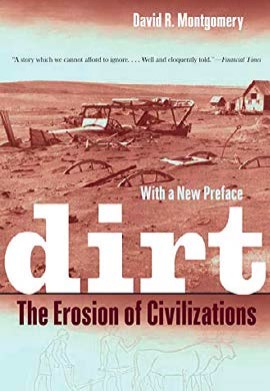
Dirt: The Erosion of Civilizations
Dirt, soil, call it what you want – it’s everywhere we go. It is the root of our existence, supporting our feet, our farms, and our cities. This fascinating yet disquieting book finds, however, that we are running out of dirt, and it’s no laughing matter. An engaging natural and cultural history of soil that sweeps from ancient civilizations to modern times, “Dirt: The Erosion of Civilizations” explores the compelling idea that we are – and have long been – using up Earth’s soil. Once bare of protective vegetation and exposed to wind and rain, cultivated soils erode bit by bit, slowly enough to be ignored in a single lifetime but fast enough over centuries to limit the lifespan of civilizations. A rich mix of history, archaeology and geology, “Dirt” traces the role of soil use and abuse in the history of Mesopotamia, Ancient Greece, the Roman Empire, China, European colonialism, Central America, and the American push westward. We see how soil has shaped us and we have shaped soil – as society after society has risen, prospered, and plowed through a natural endowment of fertile dirt. David R. Montgomery sees in the recent rise of organic and no-till farming the hope for a new agricultural revolution that might help us avoid the fate of previous civilizations.
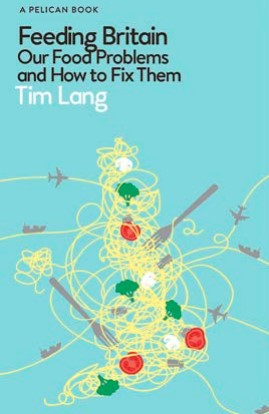
Feeding Britain: Our Food Problems and How to Fix Them
How does Britain get its food?
Why is our current system at breaking point?
How can we fix it before it is too late?British food has changed remarkably in the last half century. As we have become wealthier and more discerning, our food has Europeanized (pizza is children’s favourite food) and internationalized (we eat the world’s cuisines), yet our food culture remains fragmented, a mix of mass ‘ultra-processed’ substances alongside food as varied and good as anywhere else on the planet.
This book takes stock of the UK food system: where it comes from, what we eat, its impact, fragilities and strengths. It is a book on the politics of food. It argues that the Brexit vote will force us to review our food system. Such an opportunity is sorely needed. After a brief frenzy of concern following the financial shock of 2008, the UK government has slumped once more into a vague hope that the food system will keep going on as before. Food, they said, just required a burst of agritechnology and more exports to pay for our massive imports.
Feeding Britain argues that this and other approaches are short-sighted, against the public interest, and possibly even strategic folly. Setting a new course for UK food is no easy task but it is a process, this book urges, that needs to begin now.
-

Introduction – Issue 12
Once again I am delighted to be involved with the production of this issue, Direct Driller #12. These pages are filled with facts and figures that have the power to direct arable farmers towards more profitable and long term goals which will stand the test of time. They very much fulfil the original purpose of the magazine which Clive, Chris and I discussed some four years ago. It was made in the recognition of the huge hole that existed in farmers’ knowledge of direct drilling techniques.
The journal’s purpose was to look at every aspect of direct drilling irrespective of the contributor, be they farmers or suppliers. If you have a direct drilling experience, please let us know. Agricultural institutions in the UK and in many other countries have been slow to research and advise on direct drilling. Farmers have been largely left to fend for themselves. Direct Driller, as you will see in this and previous issues, (all available free of charge on-line) provides valuable info which, thanks to sponsors and advertisers, is provided for both in on-line and paper editions.
This issue neatly shows a wide breadth of opinion, from William Waterfield of Farm Consulting Group in his article ‘Regenerative Agriculture – Another Passing Fad or a System Fit for the Future?’ which concludes by saying it is ‘a system of agriculture that is truly sustainable with the potential benefits for consumers and the wider environment. At the same time, it can allow farmers to diverse their systems adding value or new enterprises.’ In his article ‘Soil Cultivations: Ploughing, non-Inversion tillage and Soil Quality’ Mark Measures, a member of the Agricology Steering Group recognises the bad press gained by ploughers and confesses to be a long time supporter of the mouldboard, but not for turning down manure, ploughing in green manure, or turning over the topsoil to the depths set by regular ploughmen.
He describes the work done by Friedrich Wenz in Switzerland with shallow cultivations just 5cm deep and occasional loosening at 15 cm. In the article ‘Putting Covers into Context’ Steve Corbett, the trials manager of Agrii’s Stow Longa Technology Centre near Huntingdon, says that six years of field scale research has shown that, on their land, biology alone is not measuring up with the performance they get from cultivations. The data is taken from some 600 sites and their conclusion is that, across the country, two-thirds of cover cropping “may be a waste of time and money.” They recommend caution and the need for clear objectives.
All readers will be extremely interested in the article ‘Helping Us Buy’ from Chris Fellows, Direct Driller and TFF supremo. He describes a highly original farm input price comparison website which he and the AgriWebMedia team have developed which will provide significant savings for farmers. Anyone who buys agrichems will be fascinated by this consumerist development which allows users to check out prices paid for deliveries of a wide range of brands and products. Finally a big thanks to all readers. Please support our advertisers and mention Direct Driller when making enquiries to them.



-
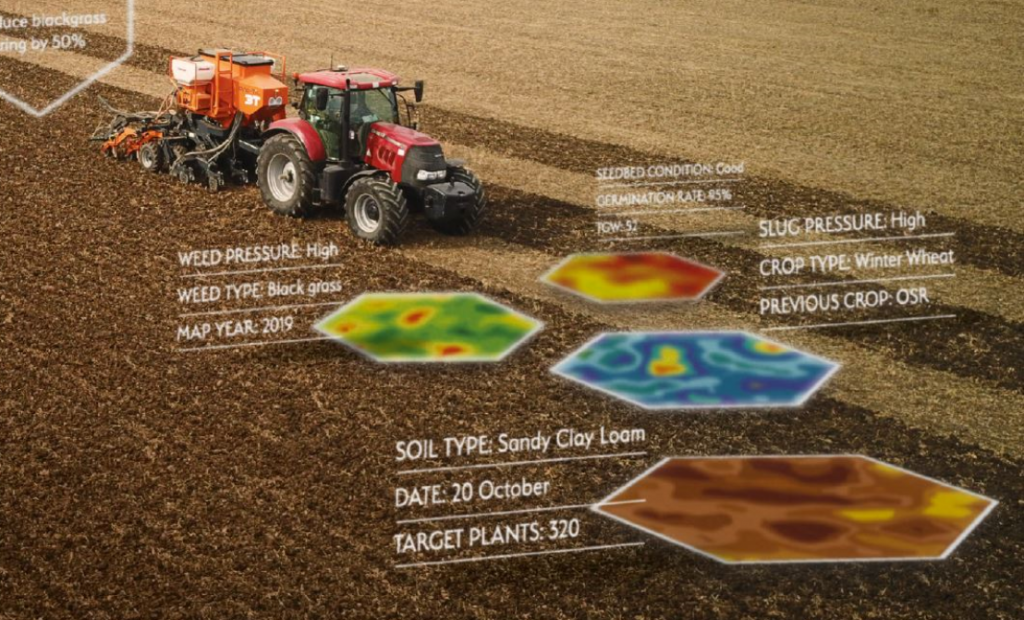
Farming Software – What do you use?
For years it was Gatekeeper – much maligned, but we were stuck with it. But in the last few years things have changed and we now live in a very congested software world. Each year more software from round the world comes to market. Here are just a few of the entrants over the last 5 years: Xarvio from BASF, Rhiza from Agrii, Hutchinson have Omnia, Plantsystems from Agrovista, Fieldmargin, John Deere and Claas have farm365. Fendt have launched Fendt One, John Deere have also just bought Harvest Profit, a provider of Farm Profitability Software.
This list isn’t exhaustive by any means.
Basically, everyone is developing software to help farmers. What could go wrong? Personally, I’m getting a bit of Deja vu. A bit like in the VHS vs Betamax wars, there will always be a winner. In this case there will be 2-3 winners, but they can’t all be winners. This is where we are going to have to get better at sharing data between systems.
Just like ISOBUS has been great to farmers on farm, we need a data version of ISOBUS so all our software can talk to each other and our data can be moved between them easily. In fact, Farm 365 is an early example of this. It allows multiple different tractors to talk to the same system. It will happen. Then there is the question of which software is the “best” and which one is the best for you? This is where it really does get complicated.
They all do slightly different things and offer different things to the farmer. They all cost different amounts too. We all like free, but free normally comes with a few catches somewhere along the line. This is where we would like to hear from our readers, if you would like to write a farmer focus piece based on farm software, then please do get in touch, some farmer feedback would help bring to clarity to the market. Maybe life wasn’t so bad with Gatekeeper after all.


-

Featured Farmer – George Young

FOBBING FARM As based on information found on Agricology (www.agricology.co.uk)
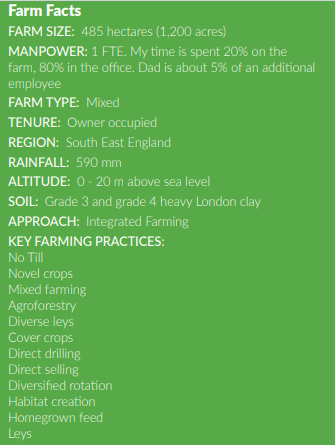
“My main goals in farming are two-fold: farming with nature as much as I possibly can, and achieving as diverse a range of nutritional diversity on the farm as possible”
The Farm:
Fobbing Farm is a 1,200 acre (485 hectare) zero tillage and zero insecticide arable and livestock farm in south Essex. We are not on the highest quality land, so my farming approach works with that. When I came home to the family farm in 2013, we were reasonably conventional farmers, occasionally ploughing, with standard chemical inputs, growing milling wheat; 7.5 tonnes (t) / hectare (ha), oilseed rape; 2 – 4 t / ha, and peas; 2.5 – 4.5 t / ha, with cattle primarily on permanent grass marshes and not integrated into the rotation. In the intervening years, I have introduced linseed, beans, heritage cereals, buckwheat, lentils, hemp, and am experimenting with sunflowers, millet, heritage corn and tiger nuts. I have also established 20% of the farm into herbal leys, and am currently investigating what dual purpose beef and dairy herd I would like.
At the end of 2020, I am planting my first field of agroforestry, with approximately 7,000 trees to be planted. These trees include a large portion of fruit and nut trees (including one belt of exotic trees – banking on climate change – almonds, persimmon, olives), plus birch trees (to harvest the sap for sugar or birch sap champagne), willow for tree mulch, and some woodland / timber trees also. I started working with Hodmedod in 2018, and have also been working on direct marketing my products, particularly to bakeries. I am about to take delivery of a flour stonemill, which will allow me to make flour of my heritage grains and buckwheat, and am hoping to be able to afford a decorticator for my buckwheat this year such that I can sell the groats.
I also developed my older farm buildings into commercial units. Agroecology is what drives me in farming. It is what I understand to be a whole farm approach based around incorporating nature into a farming system, but extends also to the way that farm products are marketed. Watch the video below to find out more…


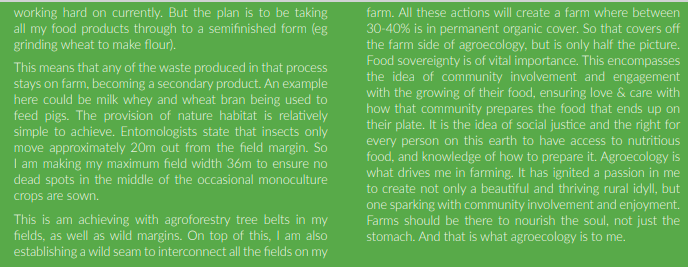
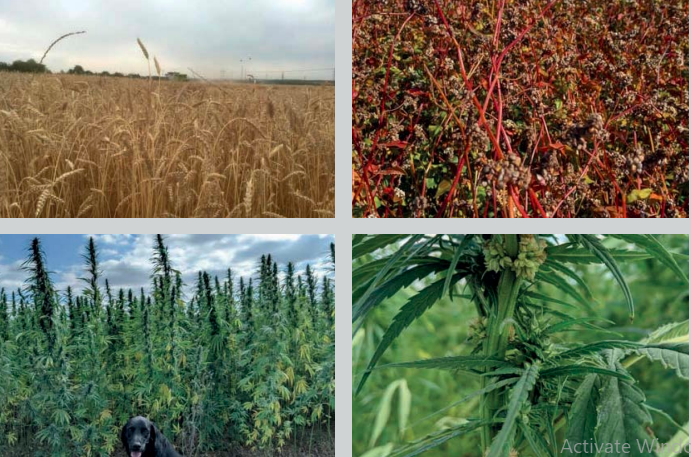

Sustainability in Practice:
The video below explains what I am implementing; diversity of crops, micro fields, turning headlands, wild margins, areas for winter bird food, woodland and agroforestry belts, interconnecting habitats, permanent forage, and providing habitat and food for pollinators…

A Systems Approach To Agriculture
The first field where I am implementing changes to my farming operation based around ecological and biodiversity principals is called Spratts. I tend to describe this as a systems approach to agriculture. Starting at the bottom of the field I have an area of winter bird food, currently in stewardship. I don’t particularly love this option, since it is so specific from a nature perspective, but it is a way in which I can receive some money for what I am attempting to do.
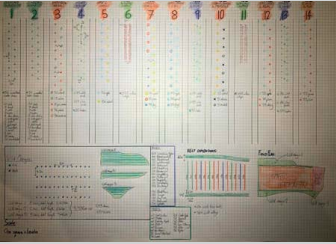
This area actually maps the wild seam carving through the middle of my farm, which interconnects each field together. Once this current option ends, this area will be planted with sporadic trees and shrubs, and under-sown with local grasses from the Fobbing marshes. The aim will be to green hay this area to get the grasses growing. I have then drawn a rectangle into the middle of the field, to make farming operations simple, and yet still manageable with large machinery.
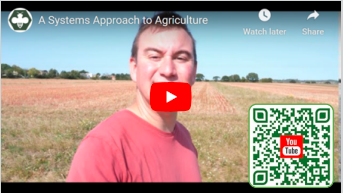
The areas of the field outside of this rectangle are being planted this winter with native trees and fruit-bushes, which over a ten to fifteen year period should become more and more wild, and I will harvest less and less of the fruit (leaving more to nature). These wild margins obviously connect to the wild seam, ensuring permanent organic cover and plenty of permanent dense habitat for the animals on the farm. At the top of the field, against the reasonably busy high road, I am planting a stretch of woodland, around 80-90m deep. In order for arable farming, especially organic arable farming, to be successful, I know I need ruminants.
However, with the top of the field open, I am concerned about visual, noise, and vehicular pollution and its effect on my livestock. So a permanent tree bank will be a fantastic buffer to this. Long term, it will also enable woodland pigs, and potentially provide building and furniture making timber for my grandchildren. A lovely term I heard recently to describe this approach is being ‘good ancestors’. Set up like this, the middle of the field would still be an ecological desert – despite all the amazing habitat creation around the field edges.
Speaking to entomologists, I learnt that insects will only venture out around 20m from the margin of any field into the unknown. So I decided to slice my field up with agroforestry belts: 6m wide belts for trees, and 36m wide alleys for arable cropping, meaning a maximum journey of 18m into the unknown for any insects, and theoretically no dead spots in the middle of my fields. I chose 6m wide belts to enable me to have double and triple runs of trees growing up them. My issue with a single row of trees is that it gives you, as the farmer, too much opportunity to be tidy – mowing both sides of the trees.
With double or triple rows, there will always be an area of wild, where nature can really feel at home. I decided not quite to call it done yet though… Conventionally, even with agroforestry, the field, including the headland, would all be cropped with one crop. But from an agronomic point of view, I have always loved the idea of what I am terming ‘micro-fields’. Ie, I am choosing to leave the headland purely as a forage crop, and to be able to turn machinery. In my instance, this is a 20m turning headland.
The micro-fields have tonnes of great benefits. For one, when you grow lots of crops (like me!), it creates distinct, logistically useful areas of set size to grow those crops. And they also give you greater rotational flexibility to deal with injurious weeds. Ie, if just one or two microfields have an issue, you can extract those from any rotation, and deal with the issue in a timely fashion. From a mob grazing standpoint, these pre-determined grazing cell sizes will work easily for managing livestock also.
The turning headlands have lots of other logistical benefits. For me to farm agroecologically, animals are critical, so having permanent forage which can be cut is useful. But they also give a permanent site for water tanks to be placed. Whenever I have visited farms with rotational livestock, their arable fields invariably have a weedy area, always described of as the place where the water tank was. This eliminates that issue. Also, not having to sow the headland of the field, means that you get away from issues like double drilling, which can lead to lodging and disease in the crop. What’s more, these permanent turning headlands link my wild margins to the agroforestry belts, ensuring the belts are an interconnected part of the puzzle also – not just islands.
There is one thing I know I have missed out here, and am scratching my head as to whether to include or not. I need a lot more water on my farm. Partly from an irrigation standpoint for when I introduce some level of market gardening, but also from a nature point of view. So there is a chance that one of the top alleys will be partly converted to a pond or reservoir… Watch this space! Hopefully that goes someway to explain this systems approach to agriculture that I am beginning to implement across my farm.
This system is thoroughly designed to work for me converting to organic agriculture – this is habitat creation on a massive scale to ensure I have lots of beneficial insects at my disposal! But critically, this system would also work spectacularly well for large farming operations, still utilising all of the artificial inputs with big machinery. For example, I am currently not planting trees for the first 42m up my belts to ensure that a 36m sprayer has plenty of room to turn at the ends of the alleys. I am hoping to fill those 42m sections up with trees pretty soon though, when I feel confident I don’t need to be applying micronutrition or compost teas to my organic rotation.
I know that I will have mistakes within this system. I am pretty certain that the mistake which will annoy me most is deciding to plant in straight lines rather than contour planting the tree belts. But I am not going to let small point like that stop me from pushing forward with this. I am also sure that not all of my trees are going to be perfect, but worst case scenario, some trees will come out and enter the fibre market in ten or so years, and I will plant some new ones in their place. But farming would be awfully boring without mistakes. And either way, I am certain that this field, and in time my entire farm, will look spectacularly gorgeous and be abundantly productive in a truly diverse range of nutritional groups, with beautiful, bountiful biodiversity.
MOTIVATIONS:
My main goals in farming are two-fold: farming with nature as much as I possibly can, and achieving as diverse a range of nutritional diversity on the farm as possible. When it comes to farming with nature, I often take a few moments to just sit out and about on the farm and contemplate what is going on; be that lying in an herbal ley watching the clouds pass and listening to the creatures buzzing about, or taking a moment on a tree stump by the pond watching the dragonflies do battle. Each farming operation I interrogate as to its necessity, seeing if there is a way that I could utilise a natural system to accomplish the same result. The simplest example of this is rotating cattle over my arable land (which I am only just beginning to do), rather than having to specifically spread muck on the arable to increase the soil ecology. That being said, given our soil types, we are rarely able to outwinter stock, so consequently there will always be an amount of manure to deal with.
In terms of nutritional diversity, I have always had an issue with not knowing what happens to a product once it leaves the farm gate. This has begun more of a direct sales approach, which is only becoming more fervent. A lot of my cereal crops now go direct to bakers (and will soon begin being milled on farm too). This way I know that these bakers will be doing their best to extract the nutrition from that grain by making it bioavailable (usually via long fermentation). However, I also strive to produce a lot more than just beef and cereals. Historically my farm (under my grandfather and great uncle’s management) grew a lot of picking peas and veg for the London markets. We might not have the best land for market gardening, but it is something I am looking into and trying to find a business partner to work with me on that. The fruit and nut trees are also another fantastic source of diverse nutrition.
Besides that, I am also keen to ensure that we are catering for an ever-increasing vegan market, and so consequently looking at crops with decent protein levels. Lentils, peas and beans obviously fit the bill, but a lot of our land is pulse sick, and so I am looking at hemp and some other high protein crops to fill the void.
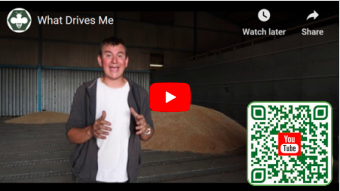
Compostable clothing is also very high up my agenda, so I am working on a flax project with a young costume designer for next year, and am hoping to begin using the fibre from my hemp also. I am a passionate agroecological farmer, trying my utmost to farm in harmony with nature as much as I possibly can. My biggest driver in all this is real food. Food, prepared well, with lots of bioavailable nutrition has the chance to really positively change how we manage our landscape in its entirety. This point about food is one of the key tenets of agroecology – thinking about the market and knowing where my produce is going.
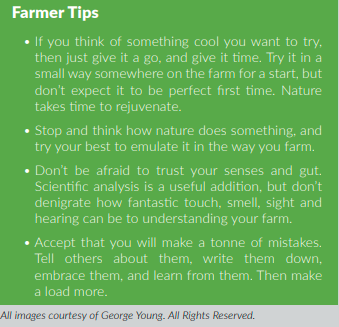
Visit www.agricology.co.uk to view this profile in full. Agricology is an independent collaboration of over 40 of the UK’s leading farming organisations sharing ideas on sustainable farming practices. We feature farmers working with natural processes to enhance their farming system, and have a wide range of farmer videos on our YouTube page. We also share the latest scientific learnings on agroecology with the farming community from our network of researchers. Our website hosts over 400 articles on different agroecological practices. In response to social distancing we are hosting a series of online virtual field days on a range of agroecological practices in collaboration with our partners. Subscribe to the newsletter or follow us on social media @agricology to keep up to date and share your questions and experiences with the Agricology community

-

Rethinking Permanent Soil Cover – Joel Williams
Permanent soil cover! One of the three pillars of conservation agriculture and rightly so. There are numerous benefits to soil health and crop production that stem from this foundational soil protective principle. However, in recent years there has been an expanding body of research into soil ecology and soil organic matter [SOM] formation and this emerging evidence warrants and important rethinking and clarification regarding the use of residue cover vs living roots.
If you spend some time reading online into conservation agriculture, you might notice some subtle inconsistencies in the terminologies used when discussing the permanent soil cover principle. Often the principle is framed as ‘keep the soil covered with residue or living plants’ and sometimes it will be listed as ‘keep the soil covered with residue and living plants’. You might think I’m splitting hairs regarding the use of ‘or’ vs ‘and’, but the emerging evidence is highlighting how very important living roots and their associated root exudates are for soil function and SOM formation.
Living roots should not be an option, they are compulsory. It’s not to detract from stubble conservation or to suggest the practice should be abandoned; perhaps the suggestion is simply that stubbles are only half the job. This aboveground strategy must be equally matched with an intentional belowground strategy. Strive to implement both practices, not one or the other. Let’s explore some of the nuance why…
#RootsNotShoots
Rightly so, we have traditionally placed significant focus on stubble retention and maintaining shoot litter on the surface of the soil for a host of important reasons – protecting the soil from erosion, conserving soil moisture, providing habitat for soil dwellers and to build SOM. However, there are numerous studies that highlight that although surface shoots do help to build SOM [mainly indirectly], there is a much more efficient pathway, but we must shift our attention to belowground residues – roots not shoots1–6.
One particular study reviewed a selection of other studies that have explored this relationship between roots vs shoots. Table 1 summarises their findings and highlights what percentage of above- or below- ground carbon [C] was captured into SOM. Overall, they suggest that root inputs are approximately five times more likely than shoot inputs to become integrated into SOM6.

There are a few nuanced factors involved but overall, there is no magic secret as to why roots have a disproportionate influence rather than shoots – the primary driver is simply the fact that roots reside in the soil and that’s where the bulk of the living organisms are also found. So the spatial accessibility and point of entry of roots and exudates5 to the soil biology means they are more effectively processed into microbial biomass as compared to surface shoot-C which is far more prone to being oxidised off into the atmosphere as CO2. Additionally, the constant drip feed of root exudates stimulates more steady assimilation and lower microbial respiration as compared to larger but infrequent C additions which can induce greater respiration losses5. Down in the soil, root litter C is also far more likely to be entangled and embedded within aggregates where it is physically protected from oxidation and occluded from microbial degradation7.
What about Root Exudates?
So if root litter plays a more important role than shoot litter, the next logical question would lead us to – what about root exudates? How much of a contribution do root exudates make toward building SOM? It appears that root exudates may have historically been rather overlooked in many studies exploring SOM dynamics – and there are two key reasons for this. Firstly, the sampling of root exudates ‘in situ’ is incredibly difficult hence making them extremely hard to study8; and secondly, previous thinking was that root exudates were unlikely to ever be stabilised into SOM as they were too labile [structurally simple] and not recalcitrant [structurally complex] enough – the thought being that small, simple substrates would rapidly oxidise off as CO2, while complex substrates would slowly decay and hence remain in the soil as SOM.
However, this paradigm that only complex forms of carbon are more important for soil carbon sequestration has been displaced by a growing body of evidence that recalcitrance is not solely the most important factor for carbon stabilisation in soils7,9–11. These recalcitrant carbon compounds [such as plant structural residues] have a lower carbon use efficiency [CUE] than root exudates12–14.
In other words, what that means is that it is easier and less metabolically expensive for microbes to consume root exudate carbon than it is plant litter carbon. Exudates are easier to digest, they can be readily assimilated and this more efficiently increases the overall microbial biomass production. Degrading plant litter on the other hand, comes at an energetic cost as microbes cannot assimilate it ‘as is’. They have to synthesise and excrete extracellular enzymes first, which externally process and digest the complex litter into smaller components, which only then can be assimilated.
Consequently, the synthesis of these extracellular enzymes wastes or costs microbial energy and overall, microbes grow less biomass per unit of C when feeding on litter vs exudates12–14. How more or less efficiently different C inputs grow microbial biomass is a critical factor because as recent studies suggest, it is dead microbial bodies [microbial necromass] that contributes so significantly to the genesis of SOM15,16 and root exudates are estimated to fuel more than 50% of belowground foodweb activity17–19.
Roughly put, the more efficiently we can grow microbial biomass, the more potential to ultimately sequester SOM – and root exudates have a higher CUE than litter inputs12. Again, I must stress that litter inputs still play a role and are still important overall to create the microclimate for the soil, but here I am focussing on ‘efficiencies’ and in this context, gains are to be had by shifting thinking belowground.
Going Belowground
What does all this mean from a practical application point of view? How do we interpret the science into applied and actionable strategies for soil health? Does the new evidence supersede previous paradigms of soil carbon sequestration or do we need to integrate them together into a consolidated view? Stubbles may well be the less ‘efficient’ way to build SOM but they sure bring hugely significant benefits to overall soil function by protecting the soil and creating an ideal microenvironment for the belowground interactions to work more efficiently. Not to mention their importance for birds of course.
Residues for moisture conservation may also become more and more essential [particularly in east], but perhaps what we need is an additional focus on root biomass and maintaining a living root in the soil as well. How the principle will be applied should be interpreted and translated into the field conditions on a farm by farm and case by case scenario. But for example, some strategies to maximise the performance of living roots might be:
1. Cover crops – help to extend the growing season outside of the main cash crop season and hence help to maintain a living root for more months of the year. Cover crops are also an ideal means to select some deeprooted species to encourage greater root biomass production.
2. Intercropping – intercropping and companion cropping hold great potential as the companion plant could be selected for its belowground rooting behaviours – for example grow the cash crop for its shoots [yield] and the companion for its roots and exudates [SOM]. Legumes are a particularly good choice as a companion due to the higher quality residues they input into the soil. Relay intercropping with cash crops can also extend the number of days with living roots in the soil and that means more highly efficient exudates leaking into the soil.
3. Integrate Perennials – perennials allocate more C belowground than annuals and being perennial, of course they maintain a living root in the soil for longer. The use of rotational leys integrated with livestock can also help across an arable rotation.
4. Increase the root:shoot ratio – select varieties of both cash crops and cover crops with more root biomass and better root traits – deeper roots, more branching roots and more fine roots are particularly ideal. Traditional varieties hold particular potential but even modern varieties have much variability in rooting biomass.
5. Increase plant species diversity – different plant species have different rooting architectures, root depths, root C:N ratios and root exudates.
In Summary
There is no doubt that covering up and protecting the soil surface is of fundamental importance for optimising soil quality and crop productivity. With the recent interest in building soil carbon levels, it is clear a greater focus on strategies to also encourage belowground carbon allocation is required. Traditional efforts focussing solely on maximizing the amount of residues on soils and minimizing physical disturbances such as tillage, may need to be rethought to ensure that the performance of living plants within the system is integrated for both yield and soil functioning. Consequently, coupling together both the use of stubble residues and living roots should be a key priority moving forward; along with selecting species or varieties of cash and cover crops with greater root biomass and designing with more plant species diversity.
References
1. Greater humification of belowground than aboveground biomass carbon into particulate soil organic matter in no-till corn and soybean crops. (2015). doi: 10.1016/j. soilbio.2015.02.014
2. Is soil carbon mostly root carbon? Mechanisms for a specific stabilisation. (2005). doi: 10.1007/s11104-004- 0907-y
3. Below-ground carbon inputs contribute more than aboveground inputs to soil carbon accrual in a bioenergy poplar plantation. (2019). doi: 10.1007/s11104-018-3850-z
4. The root of the matter: Linking root traits and soil organic matter stabilization processes. (2018). doi: 10.1016/j. soilbio.2018.02.016
5. Microbial formation of stable soil carbon is more efficient from belowground than aboveground input. (2018) doi:10.1038/s41561-018-0258-6.
6. The Ecology of Soil Carbon: Pools, Vulnerabilities, and Biotic and Abiotic Controls. (2017). doi: 10.1146/annurevecolsys-112414-054234
7. Soil organic matter turnover is governed by accessibility not recalcitrance. (2012). doi: 10.1111/j.1365- 2486.2012.02665.x
8. Sampling root exudates – Mission impossible? (2018). doi: 10.1016/j.rhisph.2018.06.004
9. How relevant is recalcitrance for the stabilization of organic matter in soils? (2008). doi: 10.1002/jpln.200700049
10. Soil aggregation and carbon sequestration are tightly correlated with the abundance of arbuscular mycorrhizal fungi: Results from long-term field experiments. (2009). doi: 10.1111/j.1461-0248.2009.01303.x
11. Sub-micron level investigation reveals the inaccessibility of stabilized carbon in soil microaggregates. (2018). doi: 10.1038/s41598-018-34981-9.
12. Evidence for the primacy of living root inputs, not root or shoot litter, in forming soil organic carbon. (2019). doi: 10.1111/nph.15361
13. Leveraging a New Understanding of how Belowground Food Webs Stabilize Soil Organic Matter to Promote Ecological Intensification of Agriculture. in Soil Carbon Storage. (2018). doi:10.1016/b978-0-12-812766- 7.00004-4.
14. Managing Agroecosystems for Soil Microbial Carbon Use Efficiency: Ecological Unknowns, Potential Outcomes, and a Path Forward. (2019). doi: 10.3389/FMICB.2019.01146 15. SOM genesis: Microbial biomass as a significant source. (2012). doi: 10.1007/s10533-011-9658-z
16. Quantitative assessment of microbial necromass contribution to soil organic matter. (2019). doi: 10.1111/ gcb.14781
17. Exploring carbon flow through the root channel in a temperate forest soil food web. (2014). doi: 10.1016/j. soilbio.2014.05.005
18. The carbon we do not see – The impact of low molecular weight compounds on carbon dynamics and respiration in forest soils: A review. (2005). doi: 10.1016/j. soilbio.2004.06.010
19. The underestimated importance of belowground carbon input for forest soil animal food webs. (2007). doi: 10.1111/j.1461-0248.2007.01064.
-
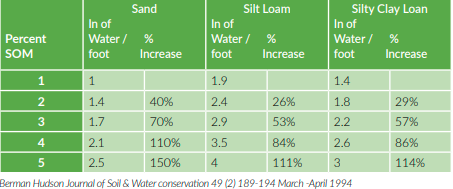
Regenerative Agriculture Another Passing Fad Or A System Fit For The Future?
Written by William Waterfield from The Farm Consultancy Group
Open just about any agricultural journal and one is bombarded by stories about regenerative agriculture but why all this interest? The confusion surrounding the subject is compounded by terms such as holistic management circular systems, closed production cycles, conservation agriculture, agroecological systems, enterprise stacking, agroforestry, mob grazing, herbal leys or new business models and that is before one starts to consider terms such as mycorrhizal fungi, liquid carbon pathways, rooting zones and the plethora of techy geek speak that surrounds just about any subject these days.
So, what is Regenerative Agriculture? two definitions sum up the situation. The first from Robert Rodale the son of the founder of the Rodale Institute in the United States defines it as “A holistic approach to farming that encourages continuous innovation and improvement in environmental, social and economic measures.” The second from Gabe Brown a US farmer from North Dakota who defines it “regenerative agriculture is a renewal of the food and farming systems which aims to regenerate the topsoil, increase biodiversity, improve the mineral carbon and water cycles whilst improving profitability throughout the supply chain.”
These two definitions clearly show that regenerative agriculture can be more than just about the farming practises that are being carried out. It is a systems approach to agriculture and the food supply, encompasses the whole food system highlighting the broken and linear nature of the current supply system. One which is dominated by a few multinational players and loses any connection back to the farm and the impact that the current system is having on the whole eco system that we depend on.
At the heart of regenerative agriculture is the understanding that we are all dependent on the top few inches or centimetres of soil on this planet. That we have failed to grasp how important it is to look after this finite resource, ensuring that the whole production cycle uses less finite resources and becomes more efficient whilst ensuring that the benefits from this are better shared by all the stakeholders including consumers.
As Robert Rodale put it it’s a continuous learning process, one that is based on the fact that the only free source of energy is sunlight and that plants alone can harvest it. When we focus on this it becomes obvious that we need to understand the role that plants above and below ground play in this process and how we as farmers can help to maximise this biological process.
Approximately half a plant’s dry matter is below ground and until recently out of mind, however without the roots and their connections the system clearly falls down. Understanding what goes on below ground and how this drives the whole above ground system is key to agriculture. The below ground eco system is hugely complex and only recently becoming understood, in that there is greater species diversity in a teaspoon of soil than there is in a rain forest. To put it simply, plants exchange some of their photosynthetic gains (sugars and carbohydrates) with the eco system below ground in return for the essential nutrients that the plant needs to grow and survive and in so doing build organic matter.
Table 1 Organic Matter and Available Water

Why is Soil Organic Matter Important?
Increasing soil organic matter has four major benefits some of which may sound contradictory:
• Improved water holding capacity
• Improved cation exchange capacity (nutrient holding)
• Better soil structure (drainage)
• Carbon sequestration
The farmer’s role therefore starts with the aim of ensuring that the below ground eco system is happy, healthy and productive. This is the core of Regenerative Agriculture and upon this the whole system can be built. The critical components required by productive below ground communities are that they are not disturbed (reduce cultivation), they have a continuous source of food (continuous above ground plants cover), that they perform best when they are very diverse and are not upset by large dollops of inorganic material. Sounds simple doesn’t it, but does regenerative agriculture work? Let’s start by looking at some of the claims for organic matter.
One of the major claims for organic matter is that the more you have the more drought tolerant your soils. Table 1 below from way back yonder shows that simply increasing soil organic matter by 1% increases its water holding capacity by 30 – 40%
One of the fundamental tenants of regenerative farming is that it’s the farming practices that influence the level of organic matter in the soil. Table 2 show the results from four neighbouring farms in North Dakota US which we can assume have broadly similar soil types but different farming system. We can see that Farm 4 is the only one who has significantly higher level of soil organic matter but combines all the elements as well as livestock. That’s great but it doesn’t confirm that the organic matter has any effect on the availability of nutrients. Table 3 is from the same four farms and shows the level of the three major nutrients plus the level of water extractable organic carbon which is an important component in the soil food web. Here again the high organic matter soil has higher levels of available nutrients.
Carbon Sequestration
It’s widely claimed that the soil can help to lock up carbon and that agriculture and forestry can be part of the solution to global warming. Looking at the level of carbon in the soil after a number of years we see that the farming system has a major influence and after just 5 years the level of carbon is significantly higher than on the traditionally managed farms. At this point the question that is usually asked is does it work – economically and productively? To fairly assess the full impact of regenerative practices we need to consider the effect that the alternative (conventional system) is having, be it on the environment or water quality and whilst this data is available it’s beyond the scope of this article.
Table 2 Organic Matter and Farm System

Table 3 The Effect of Soil Organic Matter on Available Nutrients

Table 4 Farming System and Soil Sequestration of Carbon

The Economics of Regenerative Agriculture
A systems approach such as regenerative agriculture demands that we should start looking at the whole system or at least all the component parts of the system. Approaches that only counts the £ of income or the gross margins are no longer any good. Many would argue that we let ourselves down if we do not consider the true costs. We as farmers impose costs on those down stream from us be that water companies or the natural environment.
In accounting for our activities, we have to start somewhere and accepting that you can’t be green when your accounts are in the red and therefore counting the pennies is probably a good place to start. Many arable farmers who have moved into regenerative agriculture via direct drilling route will have seen a release of capital from machinery no onger required to be replaced by a very expensive direct drill. At the same time substantial savings in overhead costs with lower labour, machinery repairs and reduced fuel bills.
For livestock farmers, a move towards a more grazing based system results in a reduction in feed costs and when accompanied with outwintering substantial reduction in capital as well as lower running costs. With improving soil organic matter and the associated increase in available nutrients, a reduction in fertiliser costs in nitrogen where annual reduction of at least 10% are achieved on many arable units. Looking at the specific performance data from some of the trials it is clear that the expected benefits in terms of additional dry matter are achieved as illustrated by both the work at University of Dublin and the University of Reading.
Graph 1 Defoliation and yield of 5 sward types
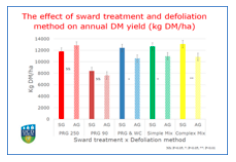
In terms of production one can consider the yield of dry matter. Work at the University of Dublin has shown that diverse leys with seed mixtures consisting of 40% Grass 30% Legumes and 30% Herbs with no artificial nitrogen out yielded ryegrass only swards receiving 250 Kg of Nitrogen by 500kg per hectare.
Graph 2 Biomass Yields from 4 sward types over three years
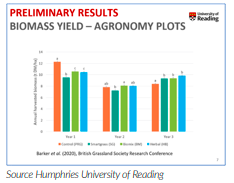
Closer to home, work at the University of Reading over a three year period has shown that the greater the diversity in the mixture resulted in increased yield. As years progress in a challenging dry season the effect of drought on PRG only sward was dramatic.
Graph 3 The effect of sward type on Lamb growth
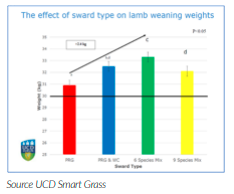
A second experiment at UC Dublin compared five swards with actual or simulated grazing. Again, this showed that the two diverse swards out yielded mono cultures. In terms of animal performance lambs of diverse swards were shown to be 2.4 kg heavier over the trial period compared to perennial ryegrass only swards. At the same time the lambs on diverse swards needed less anthelmintic treatments.
Graph 4 Animal performance across a range of sward types
Proving the economic benefits under trial circumstances is more of a problem. The preliminary results from Reading with a group of Friesian steers showed that the sward diversity was converted into increased liveweight gain.
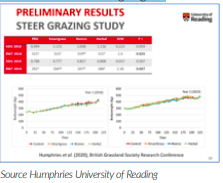
So, to answer the question in the title of this blog: No regenerative agriculture is not a passing fad but a system of agriculture that is truly sustainable with the potential benefits for consumers and the wider environment. At the same time, it can allow farmers to diverse their systems adding value or new enterprises.

-
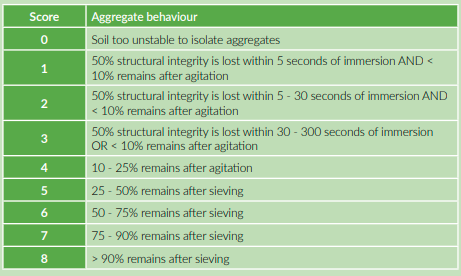
Effect Of Farm Management On Topsoil Organic Carbon And Aggregate Stability In Water
Written by Jenni Dungait
Soil health and flood management:
New research1 led by Soil Health Expert Prof Jenni Dungait and scientists in the UK and the USA shows clear links between the last time a field was tilled, the amount of carbon in the soil, and the potential for soil to slake when wet. In a unique collaboration, the science team worked with farmers around the Tamar Valley in southwest England who belong to the Tamar Valley Organic Group and received funding from the Westcountry Rivers Trust. Abstract from the paper and link to it are included below.
Climate change is causing a wetter and warmer climate in the UK
October 2020 was the 5th wettest since 18622. Farmers across the UK are looking for solutions to prevent their fields from flooding during another winter as climate change causes warmer and wetter weather across the country. Apart from the obvious problems caused by flooding when crops die sitting under water, other pests such as slugs like wet soils, and black grass and other weeds need a good drink before they can germinate. Good soil drainage is essential to avoid flooding, especially in fields with heavy soils that are at risk of compaction caused by vehicle wheeling and livestock. Installing and maintaining field drains is vital to deal with increasing rainfall, and mechanical soil loosening may be necessary if there is compaction deeper in the soil profile, but farmers can also help by improving soil structure so that it drains more quickly by increasing soil carbon.
Soil carbon can be measured on farms
Farmers are often told that it is too difficult to measure soil carbon on farms although soil scientists have been doing it for decades. For example, the national Soil Surveys of England and Wales, and Scotland have reported soil carbon values for different habitats about every 10 years since the 1990s. In this project, we also successfully measured soil carbon in the fields belonging to farmers.
Soils under permanent pasture and woodland contain more carbon than soils under arable and ley-arable rotation
managementOur measurements showed that long term permanent pasture can hold as much carbon in the topsoil as woodlands, but that any sort of tillage stops carbon building up even if there were ley-periods of up to 3 years between cultivations.
The amount of soil carbon is directly related to the last time a field was tilled
Farmers want to know how long it takes to build up soil carbon to its maximum amount. Our study showed that disturbing the soil by ploughing or other types of tillage causes large losses of topsoil carbon, and that the carbon starts to build up again when the tillage stops.
Because we looked at fields managed in different ways on each farm in the project and the farmers knew when the fields were last ploughed, we could estimate that it takes about 30 years to reach maximum soil carbon after a field that was used for intensive arable production is converted to permanent pasture or woodland.

The slake test can be used as a good soil health indicator
In this project, the ‘soil slake test’ was developed by Dr Sarah Collier who is a soil scientist who works with farmers in the USA. She used an established test used regularly by farmers across the USA and adapted it for the heavy clay soils of Devon and Cornwall. This is how the aggregate slaking was measured and scored: air-dried aggregates are placed on a sieve and put into cold water (simulating a flooded soil). Their behaviour is scored from 0-8 depending on whether the aggregates stay intact, and how much soil remains on the sieve: Our work found that the soil slake test score is directly related to the amount of soil carbon in the topsoil, and therefore also to the length of time since a field was tilled. This makes this test a great way to measure how soil carbon is affected by soil management.
How does this information help farmers cope with flooding?
Heavy soils can slump naturally if they are flooded with water. The water moving into the soil pushes out the air held in the soil structure allowing the soil to collapse in on itself, effectively sealing the soil. You can see this happening for yourself if you do the soil slake test using aggregates taken from the soil.
Soil slaking and soil carbon
Soil with a good structure crumbles easily in your hand into rounded peds or aggregates that maintain their shape in water. We found that the more carbon was in a soil, the more stable soil aggregates were in cold water. Soil carbon plays a major role in keeping soil structure in good shape to allow water to drain and move through the soil. Farmers can build soil carbon by avoiding unnecessary tillage, and particularly avoid having bare soil, by growing cover crops, retaining crop residues, and applying composts and animal manures. This is also food for beneficial soil biology like earthworms whose burrows act as vertical drainage channels.
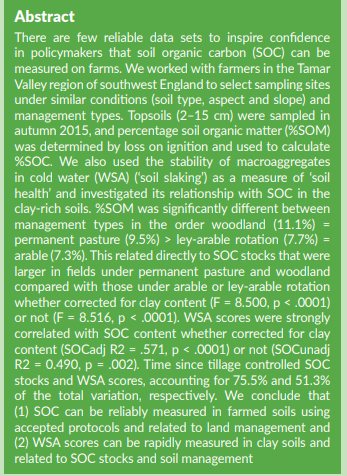
References
1 Collier, SM, Green, SM, Inman, A, et al. Effect of farm management on topsoil organic carbon and aggregate stability in water: A case study from Southwest England, UK. Soil Use Manage. 2020; 00: 1– 14. https://doi.org/10.1111/sum.12658
2 https://blog.metoffice.gov.uk/2020/11/03/uk-sees-fifth-wettestoctober-since-1862/
-

Farmer Focus – Tom Sewell

As I sit down to write my latest article, I’m reminded that 8 years ago today I was awarded a Nuffield Scholarship. I was selected as part of the #Nuffield13 year group to study “The long-term benefits of no-till farming”. I remember walking onto the stage at the Nuffield conference to be presented with my tie by two very high-profile farming personalities, one of whom said, “It won’t work in a wet year”!
Interestingly, that was in November 2012 at a hotel in Stratford, surrounded by very wet and soggy fields!
Looking back over the past 8 years its incredible to think how much I have seen, heard and learnt in that time. We continue to make mistakes and frustratingly, we continue to make some of the same mistakes. These are usually cultivating lightly/shallow or subsoiling. We do these cultivations for very good reason, but I almost always regret doing so!
This year has been no exception!
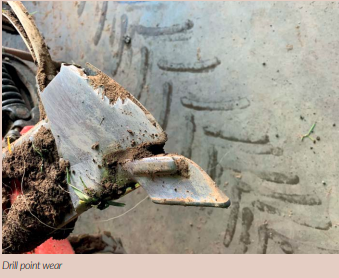
I have a quote on my workshop wall that says, “in the midst of difficulty lies opportunity”. Well this year has certainly been a challenge, but we have also had many opportunities to take on extra land both to rent and contract. These new pieces of land come in various shapes and sizes (normally small, rocky and with lots of corners!) and having been farmed in different ways by different people. Some of the new land is ex orchard so has needed to be levelled and subsoiled. Some bore the brunt of a horrific 2019 autumn and needed some care and attention, but other fields just needed the rocks picking up then straight in with the drill.
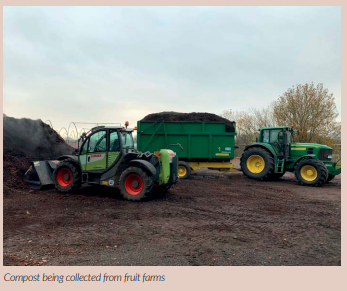
This autumn we have planted 900 acres of wheat in 55 fields between me and Dad using our 4.8m cross-slot and a 4m Horsch Sprinter. The option of a tine and hybriddisc drill has enabled us to drill wheat into a number of previous stubbles/crops. These include: wheat, barley, oilseed rape, lavender, pear & apple orchard, beans, grass, fallow, spring oats, grain maize and cover crops. To be fair most of the wheat ranges from “pretty good” to “ok”. The bits that are struggling are where we had to level some lavender beds and the seedbed was very fine, and a late grubbed apple orchard that was then cultivated and drilled in less than ideal conditions. Having said that, the purchase of a second-hand 4m Horsch sprinter in the spring allowed us to get some crops in where otherwise we would have struggled.

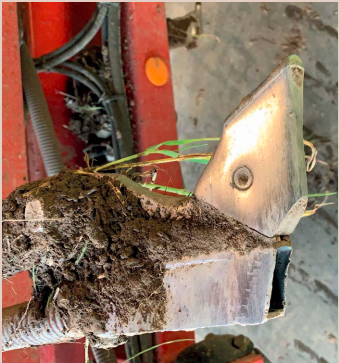
We took the opportunity to try out a number of different drill points on the Sprinter to assess their suitability on our ground. The drill planted 100ha of beans in November direct into spring barley stubbles. The drill was fitted with 1” Dutch points, 2 legs with Bourgault VOS 19mm points and 2 legs with Metcalfe 12mm points. The difference in performance and wear rates was staggering and the conclusion was that the drill will be fitted with 19mm VOS points from now on! For the first time in 2 years we can now say that we have everything planted that we had planned! The drills are washed, oiled and away and thoughts turn to winter jobs.
We are bringing in compost from a neighbouring soft fruit grower (strawberry & raspberry plants), grubbing another orchard and working on logistics for next harvest given that we are now farming for 14 separate landowners!! It’s odd to think that there are no meetings, shows or farm walks to look forward to this winter. There’s not much spare cash floating about after one of the worst harvests on record either so a “make-do and mend” approach will see us spend plenty of time in the workshop this winter. Thankfully, it has a kettle and a wood burner!
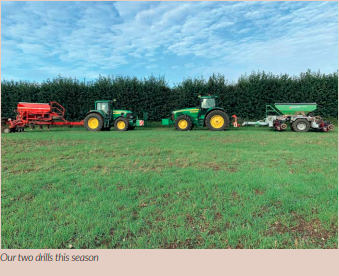
When I think back to the couple of years of my Nuffield Scholarship travels and all that entailed the main four findings still ring true. These were……
1) Embrace low disturbance no-till seeding
2) Retain residues on stubbles after harvest (or muck for straw)
3) Use diverse rotations including spring breaks and legumes 4) Grow cover crops between cash crops and keep a growing root in the soil
Looking back at these simple 4 principles I honestly think that they still ring true for us on our farm in South East England. It’s so easy to think that things must change and evolve but this year the main conclusion for me is “Less is more”!!
Our best emerging wheats are where we have drilled direct into stubbles with the cross-slot. Anything cultivated, scratched, subsoiled or ploughed looks a very distant second to the No-till crops. Yes, we do have 2 fields that are following the plough! They are ex pear orchards and were offered to us by a new landlord at 24hrs notice!! They had already been ploughed so we just levelled them with a Heva discroller and drilled with the Sprinter. The consistency in emergence of crops where the field has been in a no-till system for over 5 years is really impressive with even crops right up to the hedge. The number of undisturbed worm channels and root fissures within the soil profile help drainage, aeration, root development and really don’t want tampering with!
Without a busy winter of meetings ahead it’s easy to lose contact with other farmers and miss out on those chats and catch ups at shows we always look forward to. Over the past couple of weeks, I’ve been able to chat to a number of farmer friends and it’s always good to hear what everyone’s up to! Do give a friend a call over the winter just to see how they are doing and catch up on what’s going on.
I’m very fortunate to not only have completed a Nuffield Scholarship but also the Worshipful Company of Farmers ABM course and am currently on the Leadership Programme run by the Institute of Agricultural Management. The friends made on these courses have, in many cases, become friends for life and it’s great to catch up with them. I do love to hear which farmer is buying what drill and how many horsepower they think they will need to pull it! From a number of conversations, it seems as though production lines will be very busy building drills for the UK market and that all the ‘Cool-kids’ will have red 12m drills to play with next year! I look forward to watching with interest, whilst not forgetting that other favourite quote of mine “comparison is the thief of joy”!!!
Lastly can I wish you all a well-deserved rest over Christmas and the New Year. If 2020 has taught us anything it is to value those around us and get our priorities in order.
May 2021 be a normal year! Whatever that is?!
-
Soil Health – Applications And Opportunities For Climatesmart Farming, Food Security And Environmental Integrity
Written by Neil Douglas Fuller of the Atlas Sustainable Soil Programme
Soil health is a product of interactions between plant roots and the living fraction of the soil, operating within the constraints of the physical, chemical and climatic parameters of the soil environment.
In part, soil health is determined by the inherent, effectively fixed, properties of underlying geology, topography and landscape processes. Of equal importance are the dynamic soil properties that are influenced by land use and soil management practices, each of which can induce incremental changes to the functional characteristics of soil. Defining those characteristics, and developing the associated metrics and measurements required to effectively monitor and manage them, is fundamental to achieving sustainable farming and food production.
Society’s foundation
Soil is often considered to be the foundation for agricultural productivity, food security and environmental integrity. The majority of our air, water, fibre and nutrition is derived from soilbased eco-systems. History illustrates the social, economic and political importance of soil, and the role that soil degradation has played in the downfall of many a civilisation, both ancient and modern. Right now, soil provides a cornerstone for the global response to climate change and occupies the centre-ground for strategies designed to reverse global warming.
UK strategies
In 2019 the UK became the first major economy to declare a “Net Zero Carbon” agenda, to be realised by 2050. Coupled with the promise of a “Green Brexit”, the requirements of the “25 year plan” and the clear intent to replace Common Agricultural Policy support mechanisms with an Environmental Land Management Scheme, that fully integrates the twin objectives of food production and environmental protection, soil health is now firmly in the political spotlight. Yet despite all this, the wonderfully diverse, intricate and incredibly complex array of soil-based ecosystems that constitute the agricultural and environmental heart of the United Kingdom are in steady decline. On average, the total carbon reservoir in arable soils in England has been returning to the atmosphere at rate of around 0.6% per annum since the introduction of artificial nitrogen fertiliser and the four-furrow reversible plough.
Global issue
The global situation is very similar, with some studies estimating that the carbon stocks of agricultural soils have reduced by half, releasing around 140 billion tonnes CO2e back into the atmosphere. As carbon is synonymous with life on this planet, the implications for this, in terms of soil life processes and the degradation of soil health, could be considerable. This loss of soil carbon presents a major threat, both directly, on farm performance, food quality and soil resilience. Indirectly it impacts biodiversity, natural capital and eco-system service provision and regulation. Land managers, strategists and policy-makers are becoming more aware of this, and a whole suite of regenerative soil and crop management practices, have been designed to move carbon from the atmosphere, where it is causing problems, and place it safely into the soil, where it belongs. However, their deployment is being delayed, frustrated and compromised by one overarching limitation – the measurement, evaluation and quantification of soil health.
Soil health
Essentially, health is a function of life processes. As such, associating the concept of health to soil, implies that this vital, but fragile, global resource is, in fact, alive. This is in stark contrast to the more mechanistic view that soil is basically a mix of weathered rock and plant residue; or the pragmatic belief that soil is primarily a growing media, the functionality of which depends on the need for soil to be cultivated, fertilised, tempered and conditioned. Classifying soil as a living eco-system is a paradigm shift for many agronomists, farmers and land managers. And with this shift comes a knowledge gap, both in terms of quantifying appropriate soil life processes and in evaluating the incremental impact that discriminatory management practices may transfer onto those processes.
Classification
Traditionally, focus has been placed on inherent soil qualities; the content of sand, silt and clay; the effect of underlying geology on acidity, nutrient status and water movement; the impact of aspect, topography and climate on plant performance. As a result, the success of land management practices was most often noted in terms of biomass production, soil nutrient status, alkalinity and conductivity. More recently, soil quality metrics have been introduced as part of the evaluation process, incorporating factors such as visual assessments of soil structure and earthworm populations; observational assessment of compaction and erosion risk; in-field measures for water infiltration, aggregate stability and soil bulk density.
Carbon measurement
One fundamental component, routinely omitted from soil analysis and quality metrics, is measurement of one of the building blocks of terrestrial life processes – carbon. Despite the requirement under Cross Compliance, routine soil testing in the UK continues to omit any direct or indirect measurement of this vital soil constituent. The situation is further compounded by the current lack of any standardised analytical procedure for the basic metric, soil organic matter content, as determined by the most commonly used method, Loss on Ignition (LOI). With a large coefficient of variation, dependent on protocol, even the best laboratories may struggle to deliver suitably repeatable results using LOI.
With the Action Plan of the Paris Agreement only seeking to achieve an annual increase in soil Carbon of 0.4% in order to halt climate change, it is possible that current soil analytics will be unable to detect positive, or negative, change sufficiently accurately to be able to inform, monitor, validated or reward the regenerative Carbon Farming practices that are now forming agriculture’s Net Zero Initiative. If soil health is going to inform agricultural policy and influence farm management practices, decisionmakers need to have access to robust, reproducible, reliable systems of measurement that can detect the incremental changes that land management practices have on the dynamics and functionality of individual soil systems.
Defining the soil health space
A brief literature search will reveal a wide range of terms and definitions used to outline the working premise of “soil health” and “soil quality”. These two terms appear to be interchangeable, although they do convey different operational parameters. In simplest form, health equates to absence of illness, while quality equates to specific attributes, one of which could be health. While both terms relate to functionality, soil health implies that the physical, chemical and biological components of soil combine to create dynamic, living, processes.
The Journal of Environmental Quality (Meanings of Environmental Terms) describes soil quality as “… a measure of the condition of soil relative to the requirements of one or more biotic species and/or to any human need or purpose”. This is taken a stage further by Doran and Zeiss (2000), who define Soil health as, “the capacity of a specific kind of soil to function, within natural or managed ecosystem boundaries, to sustain plant and animal productivity, maintain or enhance water and air quality, and support human health and habitation”.
The concept of health is also central to the applied definition proposed by Kibblewhite et al. (2008) which determines that “… healthy agricultural soil is capable of supporting the production of food and fibre to a level, and with a quality, sufficient to meet human requirements, and deliver ecosystem services essential to maintain environmental quality, quality of life for humans, animals, plants and conservation of biodiversity”. However, Toth et al. (2007) defines soil quality in slightly different terms, being “… an account of the soil’s ability to provide ecosystem and social services through its capacities to perform its functions under changing conditions”.
The ability to define those functions, and effectively measure the impact of management practices on the outcomes of those functions, is fundamental to sustainable soil management and, by implication, the impact this has on future food security and environmental integrity.
Soil health is imbued with transferable performance-enhancing characteristics that influence plant, animal and human health. Not just in terms of the nutritional bio-chemistry that supports healthy growth, development and the expression of genetic traits; but also functional metabolite-related, elicitor-induced and microbe-mediated disease resistance, abiotic stress factor mitigation, and associative adaption. Each individual attribute has specific physical, chemical and biological frames of reference.
Physical soil health
The relative content of sand, silt and clay, traditionally referred to as the fine earth fraction, defines the texture, or “feel”, of a soil. However, it is the orientation, alignment and aggregation of these soil particles that define its structure, or function. Part of this definition relates to the size and distribution of pore space, which regulates:
• water movement, retention and availability
• infiltration and drainage
• air exchange and anaerobic-aerobic balance
• soluble nutrient retention
• root development and
• primary root-microbe interactions
In essence, physical soil health defines the abiotic parameters, or hard landscape, of the rhizosphere and its associative microbial habitat.
Health vs Structure
As physical soil health declines, structural integrity declines. As pore space distribution shifts from macro (large) to meso (small) dominated, the volume of soil occupied by hygroscopic water (which is inaccessible to most plant roots and soil microbes) increases. Such water tends to extend the plasticine limits of soil consistency, elevating the risk of erosion, compaction, impaired drainage, localised saturation and run-off. This can result in the formation of anaerobic zones within the soil profile that influence carbon-nitrogen transformation and associated nitrous oxide emissions. Changes in soil microbial population dynamics can also be induced, not just within the soil around the roots, but throughout the soil profile, often detected by changes in the relative ratios of protozoa and the balance between total and active, or live, biomass of indicator microbes.
Agriculturally, this can lead to:
• significant changes in the ability of beneficial microbes to suppress pathogens
• performance limitations related to water and nutrient availability and
• reductions in the activity of rhizosphere microbes that both feed and protect plants.
Delays in seed germination and plant emergence can occur, leading to reduced expression of genetic yield potential and impaired tolerance to abiotic stresses, particularly drought, temperature and photo-oxidative stress. This, in turn, can impact yield, quality and response to inputs. Declining physical soil health can also extended the dormancy, germination and population dynamics of grass weeds, affecting the efficacy and application of selective herbicides. Sustainable improvements in physical soil health are most often associated with elevated activity in biological processes that transform carbon; mainly derived from the decomposition of complex plant residues, root exudates and microbial mucilage, which stabilise soil aggregates, maintain pore space, encourage root development and facilitate plant-microbe interactions.
Key performance indicators of this process, relative to particle size distribution, include:
• water infiltration, retention and drainage rates
• soil bulk density and shear strength
• carbon flux and carbon to clay ratio
• carbon respiration and • nitrous oxide evolution.
Additional metrics are being generated by advances in electromagnetic and hyper-spectral scanning; remote sensing of moisture, temperature and aerobic-anaerobic balance through the soil profile; and digital image analysis of soil structure to determine aggregate and pore space distribution. Penetrometer measurements to determine shear strength and structural limitations to root development are also providing useful in-field data, particularly in determining the requirements for, and working depth of, primary cultivation practices. Although shear strength often increases as a result of the improved carbon dynamics associated with bio-pore formation, this is usually offset by decreases in soil bulk density, delivering a net positive gain to physical soil health.
Chemical soil health
Although chemistry has been the focus of soil husbandry guidelines for decades, much of the nutrient availability recognised as delivering agronomic benefit to the growing plant could not be achieved without appropriate physical and biological support. Traditionally, only soil pH and the “easily extractable”, or “readily available”, levels of phosphorous, potassium and magnesium have featured in the chemical soil health toolbox. However, since the turn of the century, a steady increase in the complexity, cost and implied value of more detailed soil analysis has added depth and breadth to applied soil chemistry. The determination of soil particle size distribution and clay chemistry; the inclusion of anion-cation exchange and base saturation ratios; measurements for electro-conductivity, salinity, functional carbon dynamics and respiration-evolution rates; can all now be added to an array of major and micro-nutrient assessments.
Key nutrients
In that same time frame, focus has moved to two key nutrients, both of which have significant agronomic and environmental impact. The first of these is phosphorous; the nutrient that essentially drives root development and plant-microbe interactions. Phosphorous is strongly anionic (negatively charged) and is readily adsorbed to the cationic (positive) charge associated with humic polymers, organic matter and dominant cations (calcium, magnesium). This gives it really low mobility and uptake characteristics. However, phosphorous associated with erodible or diffusible soil particulates can enter water courses, leading to eutrophication (nutrient enrichment) and oxygen depletion of aquatic eco-systems.
As chemical soil health declines, phosphorous movement from labile, organic and biological reservoirs within the rhizosphere can also decline. In response, plant root systems may be smaller, architecturally simpler and less adventurous. This can lead to decreased root exudate production and associated microbial activity. In addition there may be a decline in bio-pore formation and soil structural integrity and increased risk of erosion, compaction and aggregate destabilisation.
All of these can have a direct impact on photosynthetic efficiency, carbon partitioning, stress response and disease resistance. An extra interaction, specific only to legumes, is a reduction in biological nitrogen fixation; a process that is very phosphorous-dependent. An uplift in physical soil health can alleviate much of this.
The second nutrient to receive increased attention is nitrogen, which essentially drives protein production, plant growth and yield. The introduction of nitrogen fertiliser has generated an increase in global food production of around 45%. However, the manufacture and application of nitrogen fertiliser can account for up to 80% of the production emissions of arable crops. Routine application of nitrogen fertiliser also provides a selection pressure for soil microbial communities, which often shift population dynamics away from symbiotic and non-symbiotic nitrogen fixing organisms, placing greater reliance on fertiliser.
In addition, current nitrogen use efficiency is low, with significant levels of nitrogen entering the environment rather than being taken up by plants. Part of the issue relates to the rapid movement through the soil profile of nitrogen in the nitrate form. On its own, nitrate entering ground or surface water represents a significant threat to water quality. But once at depth in the soil, if it encounters anaerobic conditions, nitrate can be converted into the potent Greenhouse Gas nitrous oxide.
Selective ion sensor arrays, generating real-time data for nitrate movement, soil moisture deficit and carbon dioxideoxygen levels; coupled with weather data and hyperspectral determination of both soil and plant nutrient status; are advancing predictive nitrogen modelling and decision support tools. The result is not only seen in performance uplifts and operational savings but also in reduced global warming potential and enhanced levels of environmental protection. Plants often deploy positive feedback mechanisms in response to a decline in chemical soil health, adjusting root exudate composition in order to stimulate the activity of specific rhizobacteria, promote nutrient uptake, combat abiotic stress factors and prime disease resistance mechanisms.
Biological soil health
Although often viewed as a new and emerging horizon in soil health, studies into the biological functionality of soil have a long history. However, unlike physical and chemical soil health metrics, the biological metrics currently under consideration have to contend with increased levels of spatial and temporal variability. The introduction of a conceptual framework for the soil microbial food web and associated laboratory techniques for evaluating microbial population dynamics is providing a greater insight into biological soil health.
Supported by more generic soil enzyme assays; functional carbonnitrogen determinations; the detection and evaluation of pathogen-mediated elicitor and signature molecules; and the deployment of rapid gene sequencing techniques; the biological soil health toolbox is progressively expanding. However, the inherent variability of both the composition and distribution of soil microbial communities continues to exert practical limitations on sampling and analytical protocols. Specific analytical focus has been applied to the biological processes of atmospheric nitrogen fixation by symbiotic microbes that occupy the rhizosphere or the intracellular space of plant leaf tissue. The biochemistry of converting nitrogen gas into microbial protein and plant-available ammonium is reliant on phosphorous, magnesium, manganese and iron.
The process is energy-intense, timeconsuming and often host-specific, but the commercialisation and application of nitrogen-fixing microbes would be transformative in terms of sustainability, food security and environmental impact. However, results to date clearly illustrate the importance of establishing physical, chemical and biological soil health prior to deploying this emerging technology.
One area of particular interest, outside the plant health sphere, is the role of biological soil health in carbon sequestration and transformation. Seen as instrumental to climate change mitigation, the ability for plants to move carbon from atmosphere to soil, and for soil processes to safeguard the storage of this carbon, has the potential to halt, and reverse, global warming. Realising this potential resides, at least in part, on our ability to evaluate, verify and monitor soil carbon dynamics.
Summary.
Soil health is a prerequisite for the health-related characteristics expressed by plants, animals, humans and ultimately, the planet. Monitoring soil health is fundamental to the effective management of this globally significant resource. The processes involved in regulating, maintaining and enhancing soil health are complex. As a result, no one single metric has, as yet, proven to be the definitive soil health metric. Technological advances in the realms of physical, chemical and biological analytics, coupled with innovations in sensor design and geo-bio-chemical data acquisition; evaluation of microbial population dynamics and target metabolite functionality; observational data sets generated by in-field soil assessments; determination of carbon sequestration and transformation rates; all provide valuable insight into the effective measurement, monitoring and management of soil health.
-

Drill Manufacturers In Focus…
AUTUMN DRILLING GOES TO PLAN ON THE CLAYDON FARM DESPITE THE WETTEST OCTOBER ON RECORD

As part of his series detailing the farming year on E. T. Claydon & Sons’ arable enterprise in Suffolk, Jeff Claydon, who invented the Opti-Till® direct strip seeding system, talks about establishing winter crops during the very challenging autumn and cover crop trials on the farm. The article was written in midNovember.
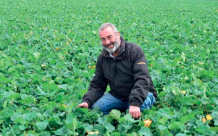
In the last issue of Direct Driller, I said that UK farmers would be glad to see the back of 2019/20 and be hoping for better weather to establish autumn-sown crops for 2020/21. Unfortunately, for many, those hopes were dashed. Remarkably, more rain fell in October than the same period in 2019. Who on earth would have expected that? On 3 October, Britain suffered its wettest day ever. An average 31.77mm of rain fell across the country, the highest since 1891. In Suffolk, we got off relatively lightly, but even so by mid-October were within 10mm of our monthly average.
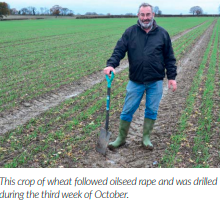
Our weather station recorded 521.7mm from 1 January to 31 December 2019. By November this year, we were close to 600mm, almost half that falling between harvest and now, with six weeks of the year to go. And Suffolk is one of driest parts of the UK! Despite that, we completed all our planned winter sowings. Being able to drill at all has been the key this autumn, as last. That has depended totally on operating a flexible system with sufficient capacity to get the job done quickly and efficiently, whatever the weather. The Claydon System has been designed to cope with these challenges. The Hybrid drill, for example, has masses of clearance between tines and can be easily tailored to provide optimum results across the widest range of crops, conditions, and soil types. To see how effective it is check out the videos of demonstrations we carried out this season at www.claydondrill.com/ video-gallery.
All Went To Plan
We have 46ha of oilseed rape this season. Of that, 40ha were drilled using 4.5kg/ha of farm-saved LG Aspire. The remaining 6ha was divided into three 2ha blocks to trial new hybrid varieties.
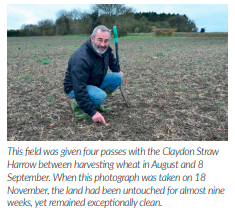
No stubble management was carried out before drilling, which is unusual, but with daytime temperatures over 30°C we wanted to conserve moisture. The crop also went in early because in 2019 we found that drilling on 10 August, compared with 10 days later, produced an additional 0.25t/ha. All the rape was drilled on 8 and 9 August, directly into chopped wheat straw using our 6m Claydon Hybrid, with 120kg/ha of Agristart granular fertiliser going down the back of the seeding tine and into the seeded bands to get the plants off to a quick start and maximise their root systems in the early stages. Then we double-rolled to promote good seed to soil contact. We had five days when temperatures peaked at a worrying 36°C, but after 25mm of rain the following week the crop jumped out of the ground. It grew away rapidly and did not get hit by the dreaded flea beetle at the vulnerable cotyledon stage.
The beetles came in late and by then the crop was at the four-leaf stage, so our early drilled rape was of little interest and has looked fantastic all season. That was not the case on the trial plots, which were drilled 10 days later and got clobbered, so early drilling paid off! We applied 4kg/ha of slug pellets a week after drilling, then on 1 September a mix of Panarex, a systemic foliar applied graminicide, Balkar®, Corteva’s postemergence autumn applied herbicide, and Toil, a 95% methylated rapeseed adjuvant oil.
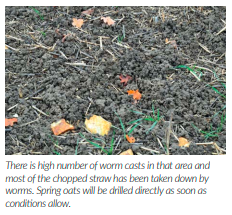
On 7 November, Kerb (Corteva) was applied to control grass and broad-leave weeds, with Ultraline for Light Leaf Spot. When I went around the farm today (18 November) the temperature was still 10°C and the crop canopy prolific. I suspect that regular pigeon patrols will be required once the weather turns cold!
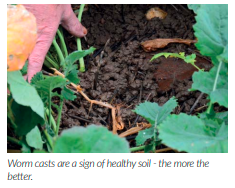
Assessing Stubble Management
Once last season’s oilseed rape had been harvested, we started straw harrowing to distribute the chopped straw evenly and create a fine, level, 2cm-deep tilth with the high-humidity conditions required to get volunteers and weed seeds to germinate quickly. Four passes at 7 to 10-day intervals, the last on 10 September, substantially reduced volunteers and weeds. We left it two to three-weeks to give the plants time to develop and provide the maximum target area for the full-rate glyphosate which went on two days before winter wheat was drilled with our Claydon Hybrid. Because harvest was so early, some fields were drilled with catch crops, but behind oilseed rape they became overthick with volunteers and had to be terminated sooner than planned. That also happened after the beans, where volunteers grew knee high.
Frequent rain meant that after 25 September we had no ‘clean wheels’ on any equipment and held off drilling the 155ha of winter wheat anticipating drier weather. But we were out of luck and with no more than a day or two between heavy downpours had to press on regardless. Drilling started on 18 October, about 10 days later than we had hoped for. The soil was wetter and stickier than we would have liked, and normally we would not drill in those conditions, but there was no alternative. That was a good decision, because had we waited the crop would have been even more difficult to drill. Almost all the winter wheat area is into LG Skyscraper. The seed was farmsaved, cleaned by a mobile processor, and treated with Beret Gold (Syngenta). Because of the wet conditions and later drilling we decided to up the rate slightly to 350/m2, which has paid off because every field looks tremendous.
A Challenging Season
Despite frequent rain, everything we planned to drill this autumn was drilled over a 10-day period by the end of October, along with 60ha of wheat and oilseed rape on a contract farm and 300ha for neighbouring farms. We were able to do this due to the high output of our 6m Claydon Hybrid and its ability to work in adverse conditions. Its support wheels run on firm, undisturbed stubbles and do not touch moved soil, so it will operate when most other strip till, min till and non-disturbance drills are stood in the shed. Warm, wet weather throughout October and November saw our crops grow away unchecked and they look very acceptable going into the colder months.
We also managed to apply all our postemergence herbicides. Half the area was sprayed with Liberator (Bayer) and Crystal (BASF), the remainder with Pontos (BASF) and Flyflo (Gemini Agriculture). Our spray programme is up to date, a huge bonus in an extremely difficult season. The key is that our 5000-litre, 24m selfpropelled sprayer can travel on the land without creating deep ruts. The Claydon Hybrid drill leave 40% to 60% of the soil unmoved, so even heavy following machinery leaves barely a mark.
Managing By Conditions
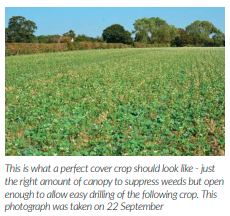
When it came to getting crops in the ground this autumn the winners were those who either did nothing in the way of cultivations or ploughed early and drilled up close behind before it turned into a soggy mess. However, working hard ground after harvest would have involved burning lots of diesel and tearing through wearing metal, as well as being harmful to soil structure and earthworm populations.
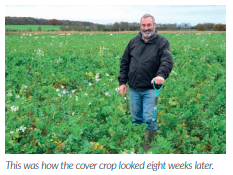
On farms where large areas of soil were moved to any depth, whether by ploughing or min-till, fields never had the chance to dry out because of the incessant rain and establishing crops became much more difficult, if not impossible. Those who min-tilled were probably hardest hit. Unfortunately, loose soil absorbed the water like a large sponge with no carrying capacity, and that is exactly what happened on many farms.
Many crops drilled in less than ideal conditions will have suffered the soil slumping and lack of air, resulting in nonexistent or poor establishment. Similarly, where disc-type or no-till drills were used in wet conditions the results can be poor because compaction will not have been alleviated and water will not have been able to drain away, so the seed rots in the rows and its development is compromised.
Look Ahead To Spring
This season we have 55ha allocated for spring sowing, all oats. They are inexpensive and easy to grow, often producing a margin on a par with winter wheat. Some of the area has been straw harrowed up to four times and then left. On some we have sown a cover crop. The idea is to see if, and by how much, cover crops improve yield and overall margin from the following crops, so we will measure the yield from each area at harvest. Obviously, if spending around £100/ha on seeds and establishment, then having to spray it off, we need to see clear agronomic and financial benefits.
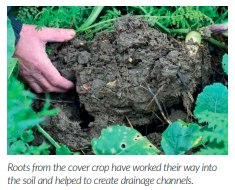
We chose Hutchinsons MaxiCover costing £35/ha, a general-purpose overwinter mix containing linseed, buckwheat, phacelia, daikon radish, fodder radish, brown mustard, hairy vetch, and crimson clover. It was drilled at 12.5kg/ha on 9 August using three seeding options on our 3m Claydon Hybrid test drill. In one area we used the standard Claydon Opti-Till® set-up comprising a patented leading tine which relieves compaction and aerates the soil, followed by a seeding tine with a 20cm A-share. In another we used the leading tine followed by our twin-tine kit. The third was drilled with the new lower-disturbance ‘LD’ twintine kit preceded by double front cutting discs which reduce power requirement and minimise soil disturbance.
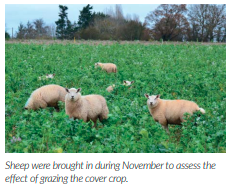
Early on when the soil was dry the lower-disturbance option did a good job, so for some farms with healthy soils and in suitable conditions that might be the best choice. But this autumn, on this farm, the standard Claydon Opti-Till® set-up produced better results. The crop established faster and was more prolific. Later in this very wet season, the leading tine created more soil fissuring, so water drained away more quickly, and the crop developed a better rooting structure. Ideally, we want the cover crop to be in the ground long enough to gain maximum advantage from the rooting structures, but not so long so that it generates excessive stick-like biomass. Some that we drilled early for demonstration purposes did just that, requiring extra work and cost to deal with it, so we will not be repeating that approach.
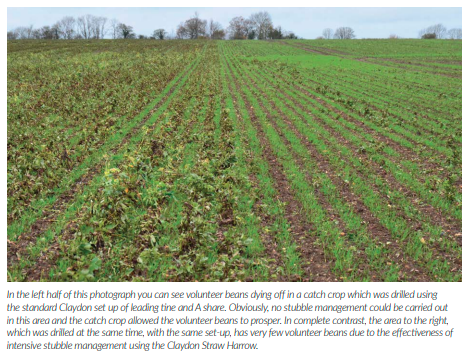
We will also avoid any cover crop that contains too much mustard, which tends to become sticky when it dies off and makes drilling more difficult. The ideal approach seems to be a mix of plant types which degrade easily and are easily incorporated, like those in Hutchinsons MaxiCover. Cover crops will be sprayed off at the end of November and those areas left until spring, when we will drill spring oats directly when conditions allow. The variety will be WPB Elyann (KWS). The last two autumns have emphasised the importance of adapting stubble management and drilling operations to suit prevailing weather conditions.
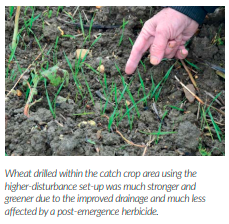
There is no one-size-fits-all ‘blueprint’ so it is critical to know your soils intimately and adapt accordingly.
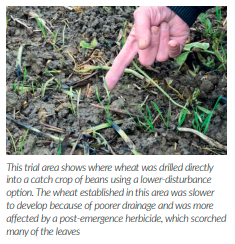
The good news for Claydon customers is that with a few simple, quick, low-cost modifications any new or existing Hybrid drill can now be used for conventional sowing, lower disturbance establishment and zero-till seeding, with or without fertiliser placement between or in the seeded rows, directly into stubbles, chopped straw, cover crops and grassland. This makes them a much more versatile, cost-effective solution compared with having to purchase a strip till drill and specialist low-disturbance drill.
Find out more about the Claydon Opti-Till® System from your local Claydon dealer, the Claydon office on 01440 820327 or the website: www. claydondrill.com
-
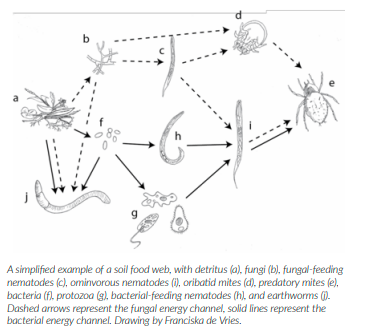
Climate Change Effects On Soil Biota In The UK
Written by Franciska T. de Vries and Richard D. Bardget
There is much evidence that climate change significantly impacts the abundance, diversity and activity of soil biota, but few consistent effects are reported in the literature, and effects vary strongly depending on environmental context. – Elevated atmospheric CO2 increases microbial biomass and the abundance of fungi (moderate confidence), the abundance and body size of most faunal groups (moderate confidence), and thus causes changes in the structure of the soil food web (high confidence). Elevated CO2 has limited impacts on bacterial diversity (moderate confidence) – Warming increases the abundance of bacteria and fungi (high confidence) and of most soil faunal groups (moderate confidence), resulting in changes in the structure of the soil food web (high confidence) – Drought increases the abundance of fungi relative to bacteria (high confidence), but decreases the biomass and abundance of most microbial and soil faunal groups (high confidence).

Very little is known on the effects of increased rainfall and flooding on soil biota, and reported effects are highly context dependent – Changes in the abundance of soil organisms and the structure of the soil food web resulting from climate change will have consequences for soil functioning and the delivery of soilbased ecosystem services (high confidence). However, the relative importance of changes in soil biota compared to direct effects of climate change on soil functioning is unclear. Links between soil biota and soil functioning are context dependent, and specific processes and functional groups need further study. For example, the impact of climate change driven changes in soil biota on disease suppression, and the extent and consequences for soil functioning of invasive microbes, remain unexplored.

-

Farmer Focus – Edwin Taylor

Well, I am sitting here thinking of how the last eight months have been since my debut article back in April and I do not think there is any way to sugar coat it, it’s just been bloody moderate (in fact probably less than moderate) with all that is going on in the world but the focus does lie at what is going on, on the farm and again faced with weather patterns that are not always conducive with farming above the snow line.
Let’s start with some positives: lock down, it did make me realise how lucky we are working in this industry. I cannot quite comprehend what it must have been like for those in large towns and cities as we all know there is a lot of advantages of being able to walk out your front door to your place of work. The schools closed which for our family life was fantastic coming as it did into a busy spring following the awful autumn of 2019. We spent more time with each other, with my son working with us and teaching my daughter to drill, and there was plenty of that ahead of us in the coming weeks. It was time spent together that is not always possible.
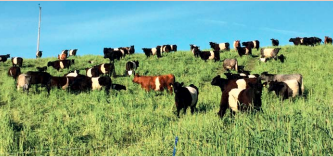
With 80% of the farm to spring crops the weather was good initially, conditions improving all the time and cereals emerging well. The prolonged dry did start to affect soil conditions especially when we started to drill our spring o-s-r after our failed winter rape. The surface had capped from the autumn’s drilling and was unable to create a good enough environment for the spring rape. I thought we still had plenty of moisture below the surface so I pulled the old Xpress out from the nettles and used that just to create that improved environment ahead of the drill. The rape emerged well and evenly on the whole but still no rain!
The cereals and beans did not seem to be taking any hurt but the rape just seemed to sit there not doing a great lot. I was thinking ‘had I done the right thing by moving more soil than some would advocate’ and it felt like weeks. But the first true leaf appeared followed by the second and third and it just took off to our great relief. The power that plants have to survive and grow is quite amazing. Then came the rain probably in time for those above the snow line and crops seemed to flourish.
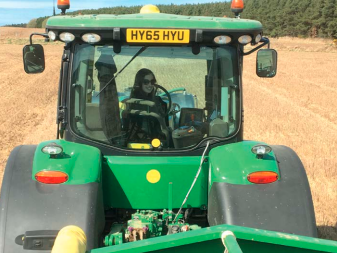
Calving started in the last week of April. Dry of course but cold, not exactly short sleeved weather. Calving 135 cows in three groups: one mob grazed; one strip grazed; and the others had been out wintered and calved on an area of permanent pasture. Also 35 heifers which had been out wintered that we brought inside for calving, normally we would have to assist some of the heifers but all calved without any help. But the cows for some strange reason were not as simple as we had to assist five – all with large calves and none ended well but that’s farming!
But with a great effort from all the team the spring calving and sowing went really well on the whole.
Of course when it starts to rain it soon feels like it forgets to stop. Hay and haylage making did seem a little tedious, crops were not as heavy due to the dry in early spring but there were windows of opportunities and just by good luck definitely not good management, we managed to make some good hay but the weather continued to feel more autumnal than summer. Harvest had started for many around us, but with us not having any winter barley it did feel a little frustrating. It was time to go on holiday but there wasn’t much appetite for that due to Covid, and not sure people and planes were going to do much for me.
So, harvest did eventually start between the showers cutting some less than average winter rape. It did not fill us with much confidence for the rest of harvest, but I have been known to be wrong once or twice before. The last few days of August saw us have a start with some wheat and considering the previous autumn and spring I was remarkably surprised with its yield but the weather was not settled and in those first few of weeks of harvest we lost at least 10 days due to rain – not large quantities just enough to be rather annoying, The weather did seem to settle and harvest continued with completion on the 10th October [it has been later] and better than anticipated on the whole.
Now for those less positive things. It often feels that there just is not enough time in a day or do you put it down to poor forward planning? I possibly plan for the ideal and not the average but then some things in farming are just out of your control and I am sure you don’t need me to tell you what they are. Winter rape and linseed have established relatively well considering wheat harvest was stop start and delayed. We have a proportion of wheat that looks ok, but for the wheat after the spring rape and spring oats, and winter beans after the spring barley that we got drilled I think we are looking at a total failure. I am sitting here thinking of a way of sugar coating it and to look for some positives but I really am struggling.
The reality is that in a normal year, if there is such a thing, you should be able to drill in the last ten days of September confident of success, but with constant rain from June not in large quantities and then the 22nd September we had 36mm and that turned our fragile soils to conditions that were just ok, so continuing to drill wheat and beans still with confidence but the weekend of the 3rd October we had 74mm over 36 hours and then another 48mm over the next two weeks. Surprisingly I think it was the last 48mm over that longer period that caused the real damage with no respite to allow ground to drain. It is rather frustrating to say the least. You question the system and what could I have done differently if anything. We have a lot of questions but not many answers. All I do know is there is nothing I can do about it today and accept the fact that there is going to be another year with a larger area of spring crop than would normally been planned we just need to turn the page and move on.
All that has focused the mind a little. You do think what could you of done differently and I think even with our small window of opportunity there are certain things we can improve on. The main thing is the growing of cover crops. I think they are so important to Regen Ag and I feel we have let slip our focus on this for stabilizing our soil and retaining nutrients over winter. Today it could have opened up opportunities for us to alter the rotation and enable us to drill a winter crop if we had a good cover crop. I think conditions would have allowed us to do that today.
I am sure that I am not the only one that has failures and you do need to surround yourself with people that build confidence and support you in anything you do as it’s not easy if it’s not the normal.
To end on a positive, on the back of Covid, my involvement as Chairman of BASE-UK and the great Committee and our administrator Rebecca who work so hard organizing webinars for our members this is what gives you the confidence to continue down the road of CA, Regen AG.
I look forward to the end of Covid and hopefully being able to be out on farm in the New Year.
-
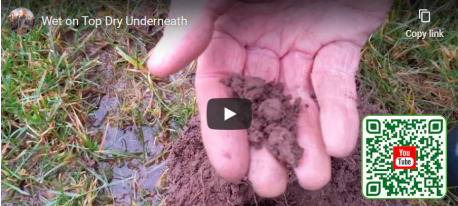
Wet On Top Dry Underneath
Written by Niels Corfield
The winter of 2019/20 has been challenging for farmers to say the least. Incessant rain meaning fields were not accessible, and winter crops were not sowed, large areas of flat or low lying country flooded (sometimes repeatedly) and otherwise generally redefining the concept of mud. However, now that we’re at the end of 2020, how’s the ground shaped up over the year? Did the moisture seem to disappear, even after the wet winter of 2019-20? When the ground across the farm (and the country), it seems, was saturated.

What if I said, that it’s the same root cause that produces both drought and flooding? That your farm, whether it be cropping or grazing, organic or conventional can be reworked to be both drought-proof and immune to extreme rain events. Sound too good to be true? Well read on.
If it’s not there when it’s wet, it’s not there when it’s dry
First we better rewind a few steps and show so how it is that a single causal factor is responsible for droughts and flooding. This single causal factor means that on the one hand (in 2018) we were feedingout first-cut silage and achieving little or no grain-fill and this winter we ended-up with maize harvests that looking like the battle of the Somme (reparable but not good optics).
Management Dictates Infiltration
Above we see two spade sample of the same soil type on the same day, margin on the left and grazed pasture, recently reseeded. Simply put the causal factor is a lack of infiltration (or low infiltration rates) in all but the lightest or stoniest of soils — and a lack of retention in these soils. The water that falls as rain has only one of two places to go it can either go into- (and through) the soil or away as runoff.
If your soil it’s very light or naturally free draining that water will go straight through, and in heavier soils that water will run-off. In both cases that water has left and has not been retained within in the soil profile. But our soils were clearly saturated this winter, I hear you say! How can you be suggesting there’s a lack of infiltration?
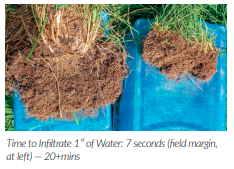
Well, the experience is, that it’s the surface of these soils that was at capacity, the bulk soil was dry, often very dry. See soil pictured below for an illustration.
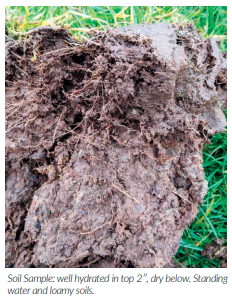
You’ve got one chance, and one chance only, to get the water into your soil and that’s when it rains, as infiltration. Without infiltration that water will run off. It’s a simple choice where would we prefer to have are rainfall: in the soil where it can grow crops and forage, or in the valleys where it fills up like a bathtub: damaging property, and causing travel disruption and economic impact? It seems counter-intuitive to say we want more water in our soils, given the experiences of winter we’ve just had. Surely, all that mud and saturation wants to be mitigated, by drainage or other means?
Well, no, in a word.
What we looking for is deep penetration into- and through the soil profile.
Structure
So what does this mean? What is this indicative of?
Simply that these soils lack pore space. They often are blocky and consolidated and largely just structured in their “native”, mineral state (where all the soil particles are bonded to each other, in a tight crystalline state). These bonds are strong, but brittle, so when they fail, they may well “cleave” along fault lines, revealing: cracks, jagged edges and angular shapes. At the landscape scale what features do we associate with these terms (and shapes)? Generally: cliffs, rock faces, and mountains. And what is the study of these materials and these types of features? It’s geology. Simply put, if your soil looks and behaves like geology: it shatters, cracks or cleaves, has the appearance of rocks or stone, it is geology.
Which makes sense because the sand, silt and clay is basically just ground up rock. However, when we refer to soil that’s just sand, silt and clay, it’s subsoil (in old money). Fundamentally, the difference between subsoil and topsoil is that topsoil is subsoil that has been acted upon by biology.
And what is biology’s influence on the soil structure? Primarily the creation of pore space. Converting the soil from its native, homogeneous state where the soil particles “pack” readily, into to a heterogeneous state, binding together disparate soil particles into crumbs or “aggregates” with a network of internal voids running between them. Just as a biscuit maker converts base ingredients, flour and sugar, into crumbs with the addition of a binding agent, like butter. Where the flour and sugar particles are effectively the same size as one another but once the binding agent is added those crumbs that result now have a large variation in size, from something like a bowling ball down to a golf ball.
In the case of the soil, our sugar is analogous to sand (coarse, granular), while the clay is analogous to flour (since if you purchase dried clay it comes bagged, as a powder). In soil, the aggregates are bound together by sticky substances like polysaccharides (carbohydrates) that are secreted by organisms like bacteria. In the same way that if you’ve ever got slug trail on your clothing it goes on sticky, cannot easily be washed off and sets hard, in other words these compounds are glue-like in nature.

So, we can say that soil aggregates are literally glued together by the secretions of biology. This is what gives boy soil it’s friable crumbly and easily workable texture. Fundamentally it’s this crumb structure and the pore space that facilitates infiltration. Over and above what the native soil does alone. Moreover, with light soils these crumbs increase the surface area and with-it water holding capacity making them more moisture retentive. Since these surfaces of the aggregates are places where water films form. And it’s these billions of tiny water films throughout the soil volume that gives it its water holding capacity.
In heavy soils the opposite is the case, it serves to make the soil more free-draining. By opening up the dense structure and introducing pore spaces. Spaces that are interconnected, through which rainfall can easily percolate whilst also collecting around the aggregates as water films. In both cases this forms a water reserve that can be drawn upon by crops and forages in the sunny, warm periods that are optimal for growth and grain fill. So, with the exception of a small number of self-aggregating soils, crumb structure is entirely a product of biological activity and an expression of the carbon cycle in action, as these are carbon-based compounds, derived from plants, often root exudates (sugars). It’s these processes at play in the above example comparing margin with reseeded pasture.
Management Determines Infiltration Rates
So, what you can do, how can you achieve this friable structure without necessarily going to grass? Simply put, apply the soil health principles at every stage of your cropping and management practices Pasture vs Covered Arable vs Bare Arable (Photo: LSU AgCenter) Simply put here in the UK we are not victims of either too much or too little rainfall, just inadequate infiltration or retention. In a cropping situation it’s not only the lack of pore space but also surface capping (from rainsplash etc) As Yoda says: “Hmm, not how much rains it matters, how much we retain, it does.” So in one fell swoop by fixing infiltration we not only do ourselves a favour: eliminating muddy conditions and poor field access options early and late season, we also optimise production through seasons like 2018.
Find out more on the courses that Niels offers, please follow the QR code.
